

Does the PSAT include an essay? Exam Breakdown
When it comes to the PSAT exam, students often wonder about the various sections and requirements. One common question that arises is: Does the PSAT include an essay?
Table of Contents
PSAT Exam Format and Sections
The PSAT exam consists of three main sections – Reading, Writing & Language, and Math. Each section evaluates different skills and knowledge areas, providing students with a comprehensive assessment of their academic abilities.
Reading Section
The Reading section of the PSAT includes 47 multiple-choice questions. These questions are based on passages from various subjects such as literature, historical documents, social sciences, and natural sciences. Students are tested on their ability to comprehend and analyze written material, draw inferences, and identify main ideas.
Writing & Language Section
The Writing & Language section consists of 44 multiple-choice questions on grammar, vocabulary, and editing skills. Students must identify and correct grammar, punctuation, and sentence structure errors. They must also demonstrate a strong understanding of vocabulary and use appropriate language conventions, including effective word choice and clarity.
Math Section
The Math section of the PSAT evaluates students’ mathematical problem-solving skills. It includes two portions – Calculator and No Calculator. The Calculator portion allows students to use a calculator for 31 of the 48 questions, while the No Calculator portion does not permit calculator use for the remaining 17 questions. The topics covered in the Math section include algebra, geometry, data analysis, and trigonometry.
It’s important to note that the PSAT does not include a separate writing section or essay component. As a result, essay scoring is not applicable in the PSAT exam.
| PSAT Exam Sections | Number of Questions |
|---|---|
| Reading | 47 |
| Writing & Language | 44 |
| Math | 48 |
PSAT Math Test
The PSAT Math test is an important component of the PSAT exam, assessing students’ mathematical knowledge and problem-solving skills. It consists of 48 questions and covers various topics, including algebra, geometry, and trigonometry.
The test is divided into two portions: Calculator and No Calculator. The Calculator portion allows students to use a calculator for certain questions, while the No Calculator portion tests their ability to solve problems without a calculator. This ensures that students can apply their mathematical skills in different scenarios and enhances their understanding of mathematical concepts.
Tips for PSAT Math Test Preparation
Here are some tips to help you prepare for the PSAT Math test:
- Review the math topics covered in your high school curriculum , including algebra, geometry, and trigonometry.
- Practice solving math problems using various resources, such as textbooks, online practice tests, and study guides.
- Familiarize yourself with the format of the PSAT Math test by reviewing sample questions and understanding the types of problems you may encounter.
- Improve your problem-solving skills, including identifying key information, using appropriate formulas or equations, and applying logical reasoning to arrive at the correct answer.
- Manage your time effectively during the test by practicing timed practice sessions and allocating sufficient time to each question.
PSAT Reading Test
The PSAT Reading test is a crucial exam component, evaluating students’ reading comprehension and analytical skills. It consists of 47 multiple-choice questions that assess their ability to comprehend and interpret passages from various subjects, including literature, historical documents, social sciences, and natural sciences.
Unlike some standardized tests, the PSAT Reading test does not include essay prompts or require essay practice. Instead, students are expected to read passages carefully, analyze the information presented, and answer questions based on their text comprehension.
🌟 Hey Students! 🚀 Ready for the ultimate experience? Join us on Studentsinside.com's Facebook , YouTube , WhatsApp , and LinkedIn . Click now for tips, fun, and success vibes! 🌈✨ #StudentLife #JoinUs
This section of the PSAT is designed to measure students’ ability to understand complex texts and draw inferences from them. It tests their comprehension of the passages’ ideas and arguments and their capacity to analyze the author’s tone, purpose, and rhetorical strategies.
The PSAT Reading test is invaluable in developing critical reading skills essential for success in college and beyond. Through practice and study, students can enhance their ability to extract information from diverse texts efficiently.
Benefits of the PSAT Reading Test
The PSAT Reading test offers several benefits to students:
- Improves comprehension skills: Students develop their ability to extract key information and comprehend complex texts by engaging with a wide range of passages from different disciplines.
- Enhances critical thinking: The test challenges students to analyze and evaluate arguments, identify supporting evidence, and draw logical conclusions.
- Boosts vocabulary and knowledge: Students gain exposure to various topics and subject matter, expanding their vocabulary and general knowledge.
- Prepares for college-level reading: The PSAT Reading test provides valuable practice for the reading demands of college courses, helping students become confident and proficient readers.
| PSAT Reading Test Overview | Number of Questions | Topics Covered |
|---|---|---|
| 47 multiple-choice questions | 47 | Literature Historical documents Social sciences Natural sciences |

PSAT Writing & Language Test
The PSAT Writing & Language test is essential to the PSAT exam. This section assesses students’ grammar, vocabulary, and editing skills through 44 multiple-choice questions.
It focuses on non-fiction passages and arguments from various subjects, allowing students to demonstrate their proficiency in understanding and improving written texts.
This section of the PSAT does not include any writing prompts or essay-related questions. Instead, students are tasked with analyzing and revising existing passages to enhance clarity, coherence, and effectiveness.
Benefits of the PSAT Writing & Language Test
The PSAT Writing & Language test offers several benefits to students preparing for college admissions exams:
- Improves Grammar and Vocabulary: Students can enhance their writing proficiency by practicing grammar rules and expanding their vocabulary.
- Enhances Reading Comprehension: Analyzing and improving written passages helps students develop strong reading comprehension skills.
- Builds Editing Skills: Revising and editing passages based on grammar and stylistic conventions allows students to refine their editing abilities.
- Prepares for the SAT: The PSAT serves as a precursor to the SAT, and excelling in the Writing & Language test can boost confidence and performance in future college entrance exams.
Changes to the PSAT Format
Starting in fall 2023, the PSAT will undergo significant changes by introducing a digital format. This transition aims to enhance the testing experience for students and provide new features to aid in their performance. While these changes bring exciting advancements, it is important to note that the PSAT format remains consistent without including an essay section.
The digital PSAT will be shorter, saving students approximately 45 minutes of testing time. Additionally, it will incorporate new tools and resources to facilitate problem-solving and analysis. These features include a built-in graphing calculator, text annotation tools, and a timer to help students manage their time effectively.
Even with these updates, the format of the PSAT remains consistent with its existing sections, which include the Reading, Writing & Language, and Math components. Each section is designed to assess specific skills in reading comprehension, grammar, vocabulary, mathematical reasoning, and problem-solving.
Importance of the PSAT/NMSQT
The PSAT/NMSQT holds significant importance for students as it is a valuable practice version of the SAT. This exam allows students to familiarize themselves with the format and content of the SAT, helping them better prepare for college admissions exams.
While the PSAT/NMSQT provides insights into a student’s academic strengths and weaknesses in critical areas such as Reading, Writing & Language, and Math, it does not include essay prompts or scoring related to essays.
Aside from being a practice test, the PSAT/NMSQT offers additional benefits to students. It provides AP potential recommendations, helping them identify Advanced Placement courses they may excel in during high school. Furthermore, strong PSAT/NMSQT scores can open doors for students to enter the National Merit Scholarship Program, which recognizes and rewards academic excellence.
Overall, the PSAT/NMSQT plays a crucial role in students’ academic journeys, offering a platform for self-assessment, encouraging academic growth, and providing access to potential scholarships and opportunities.

PSAT Test Preparation
To prepare for the PSAT, students should focus on the content covered in their high school classes and employ effective study strategies. It is essential to review and understand the course material to ensure success on the exam.
Additionally, utilizing resources such as the official digital SAT prep at Khan Academy can help students practice and improve their skills. Although the PSAT does not include an essay section, thorough preparation in other areas can still contribute to overall success.
Here are some key tips for PSAT test preparation:
- Create a study schedule and stick to it. Allocate specific times for reviewing different subjects and topics.
- Review class notes, textbooks, and any relevant study materials teachers provide.
- Practice with sample questions and past PSAT exams to become familiar with the format and types of questions asked.
- Use online resources like Khan Academy, College Board, and other reputable educational websites to access additional study materials and practice questions.
- Form study groups with classmates to discuss and reinforce understanding of key concepts.
- Seek guidance from teachers or tutors if specific areas require further clarification or assistance.
Sample PSAT Study Schedule:
| Day | Subjects to Review |
|---|---|
| Monday | Math – Algebra |
| Tuesday | Reading Comprehension – Fiction |
| Wednesday | Writing & Language – Grammar |
| Thursday | Math – Geometry |
| Friday | Practice Test Review |
| Saturday | Rest |
| Sunday | Review Weak Areas |
PSAT/NMSQT Scoring
The PSAT/NMSQT scores range from 320 to 1520 and are calculated based on the section scores for Reading, Writing, and Math. However, since the PSAT does not include an essay component, there are no specific scoring or tips related to essays.
Taking the PSAT/NMSQT
The PSAT/NMSQT is an important exam students typically take in 11th grade, although some schools may offer it to 10th graders. It is administered at schools during October and provides students with valuable insights into their academic strengths and areas for improvement.
To take the PSAT/NMSQT, students must sign up through their respective schools. The school administration usually coordinates the registration process, and students will be informed about the specific dates, locations, and procedures for taking the exam.
PSAT/NMSQT Scores and Benefits
PSAT/NMSQT scores are crucial in understanding a student’s academic performance and setting goals for future exams, such as the SAT. These scores provide valuable insights into students’ strengths and weaknesses in key subject areas and help guide their college and career aspirations.
Additionally, PSAT/NMSQT scores unlock various student benefits and opportunities, including scholarships and personalized guidance.
Scores and Score Range
The PSAT/NMSQT scores are reported on a scale of 320 to 1520. The score range is divided into two main sections:
| Section | Score Range |
|---|---|
| Reading and Writing | 160 to 760 |
| Math | 160 to 760 |
The total score is the sum of the Reading and Writing score and the Math score. These scores provide a comprehensive overview of a student’s performance across the different sections of the PSAT/NMSQT.
Benefits and Opportunities
PSAT/NMSQT scores open doors to a variety of benefits and opportunities for students:
- Scholarship Opportunities: The PSAT/NMSQT serves as the initial screening for the National Merit Scholarship Program, which awards scholarships to top-performing students. Students with exceptional scores may qualify for recognition and various scholarship programs.
- College and Career Guidance: PSAT/NMSQT scores provide valuable insights into a student’s academic strengths and areas for improvement. These scores can help students identify their potential college majors, explore career options, and receive personalized guidance to enhance their academic journey.
- Advanced Placement (AP) Potential: PSAT/NMSQT scores include information about students’ potential to succeed in Advanced Placement (AP) courses. This guidance helps students identify subjects they may excel in and consider taking AP courses to challenge themselves academically.
Q: Does the PSAT exam include an essay section?
A: No, the PSAT exam does not include an essay section. It consists of three main sections – Reading, Writing & Language, and Math.
Q: What are the sections in the PSAT exam?
A: The PSAT exam consists of three main sections – Reading, Writing & Language, and Math.
Q: Is there a separate writing section in the PSAT?
A: No, there is no separate writing section in the PSAT. The writing-related questions are included in the Writing & Language section.
Q: Are there essay prompts in the PSAT?
A: No, there are no essay prompts in the PSAT. The focus of the exam is on multiple-choice questions.
Q: Are there specific tips or formats for the essay in the PSAT?
A: No, there are no specific tips or format for the essay in the PSAT since it does not include an essay section.
Q: Are there any changes to the PSAT format?
A: Started in fall 2023, the PSAT will be administered digitally with new features. However, there are no changes to introduce an essay section.
Q: Why is the PSAT/NMSQT important for students?
A: The PSAT/NMSQT is a practice version of the SAT and helps students prepare for college admissions exams. It also provides insights into academic strengths and weaknesses and offers access to the National Merit Scholarship Program.
Q: How can students prepare for the PSAT?
A: The best way to prepare for the PSAT is to focus on the content covered in high school classes and study the course material effectively. Additional resources like the official digital SAT prep on Khan Academy can be used for practice.
Q: How are PSAT/NMSQT scores calculated?
A: PSAT/NMSQT scores range from 320 to 1520 and are calculated based on the section scores for Reading, Writing, and Math.
Q: When is the PSAT/NMSQT administered, and who is eligible?
A: The PSAT/NMSQT is typically taken by 11th-grade students in October. Some schools may offer it to 10th graders as well. Students need to sign up through their respective schools.
Q: What are the benefits of PSAT/NMSQT scores?
A: PSAT/NMSQT scores provide insights into a student’s academic performance, help set goals for future exams, access scholarship opportunities, and receive personalized college and career guidance.
Q: What are some common questions about the PSAT?
A: Some common questions about the PSAT include whether it has an essay section, eligibility for the National Merit Scholarship Program, and availability for younger grades (PSAT 8/9).

Mohammed Debon is an SEO Expert, Webmaster, and a proud parent of three. Mohammed created this website to help fellow parents find comprehensive information about various educational programs and make well-informed decisions for their children's future. With expertise in the digital landscape, Mohammed aims to streamline the process of selecting the right education system and provide valuable resources for parents worldwide.
Similar Posts

How to Convert CGPA to Percentage: A Clear and Knowledgeable Guide
CGPA evaluates a student’s academic performance. It is a grading system in many schools, colleges, and universities worldwide. CGPA measures a student’s overall academic achievement, calculated by averaging the grade points obtained in all subjects over a given period. Conversely, a percentage reflects a student’s academic performance in a specific subject or course. It is…

Why is Summer Break Good for Students? The Secrets Schools Don’t Tell You
Summer break is a time that many students look forward to each year. It’s a time when they can take a break from the stress of school and enjoy some much-needed downtime. But is summer break good for students? The answer is yes, and there are several reasons why. Firstly, summer break allows students to…

Understanding the Australian Grading System
In this article, we will explore the essentials of the Australian education system, including the levels of education, the Australian Qualifications Framework (AQF), and the categories of tertiary education. We will also dive into the specifics of the Australian grading system at the university level, how to interpret grades and GPA, the significance of ATAR…

IELTS vs Duolingo: Which is Better for Language Learning?
IELTS is a language proficiency test developed collaboratively by the British Council, IDP Education, and Cambridge Assessment English. Introduced in 1989, it enjoys recognition from over 10,000 global organizations, including universities and educational institutions. The primary aim of IELTS is to evaluate the English language skills of individuals from non-English-speaking backgrounds, particularly those aspiring to…

How Long Does IELTS Last: Test Duration and Validity
The IELTS is an important test that measures the English language proficiency of non-native English speakers. It is recognized and accepted by universities, immigration agencies, and employers worldwide. One of the most frequently asked questions about IELTS is how long it lasts. The IELTS certificate is valid for two years from the test date. This…

GRE At Home: Everything You Need to Know
The GRE General Test is a standardized test that assesses the verbal reasoning, quantitative reasoning, critical thinking, and analytical writing skills of individuals seeking admission to graduate schools. The GRE General Test can now be taken from the comfort of one’s home, thanks to the At-Home version of the test. This section will provide an…
Leave a Reply Cancel reply
Your email address will not be published. Required fields are marked *
Save my name, email, and website in this browser for the next time I comment.


- PSAT Quizzes
- Math Lessons
- Writing Lessons
- Reading Lessons
- PSAT Videos
- PSAT Scoring

What's Tested on the PSAT? (2023-2024)
The first step to achieving PSAT success is to learn about the structure of the test and why it’s so important for your future. The PSAT is a 2-hour and 14-minute exam that tests your reading, writing, and math skills. Beginning in the fall of 2023, all test-takers will take the Digital PSAT. The more comfortable you are with the new test structure, the more confidently you will approach each question type, thus maximizing your score. In this guide, we’ll review what you need to know about taking the new digital version of the PSAT so you feel confident on Test Day.
[ READ NEXT: What’s a Good PSAT Score? ]
Changes on the Digital PSAT
As of fall 2023, the PSAT will no longer be a pencil-and-paper exam. With the exception of certain student accommodations, all students will take the Digital PSAT on a computer. The test makers have shortened the PSAT by about 45 minutes, but you will still receive a score out of 1520 that can help you qualify for scholarships and assess your readiness for the SAT. Not only will you have a shorter total exam time, but you will also have fewer questions to answer and more time to spend per question.
The Digital PSAT format has other helpful new features such as a built-in graphing calculator, text annotation tools, a timer, a zooming tool, and the ability to “cross out” answer choices you want to eliminate. These features will make it easy for you to navigate the test and manage the questions.
Questions on the Digital PSAT have undergone changes as well. The Reading and Writing passages and the Math questions are generally becoming shorter in length, making it easier for you to focus on what the questions are asking.
[ LEARN MORE: College Board Going with Completely Digital SAT ]
PSAT Test Structure
The structure of the PSAT is changing slightly when the test goes digital. The Digital PSAT is 2 hours and 14 minutes long and consists of two sections: (1) Reading and Writing and (2) Math. Here’s how the PSAT will be structured:
| Reading & Writing | Module 1 | 32 minutes | 27 |
| Reading & Writing | Module 2 | 32 minutes | 27 |
| Math | Module 1 | 35 minutes | 22 |
| Math | Module 2 | 35 minutes | 22 |
| Total: | 4 modules | 134 minutes | 98 questions |
The PSAT Math Test: What to Expect
The PSAT Math section includes 44 questions divided between two modules. You have 35 minutes to answer the questions in each module. The PSAT math section tests your ability in four content areas: algebra, advanced math, problem-solving and data analysis, and geometry and trigonometry.
In the chart below, we break down what’s tested on the PSAT Math test:
| (13-15 questions) | Solving, creating, and using: – Linear equations – Linear functions – Linear inequalities – Systems of linear equations Making connections between different representations of linear relationships |
| (12-14 questions) | Interpreting, solving, creating, and using: – Equations with absolute value – Equations with radicals – Quadratic equations – Exponential equations – Polynomial equations – Rational equations – Other nonlinear equations |
| (7-9 questions) | Solving questions using: – Ratios – Rates – Proportions – Units – Percentages Analyzing and interpreting data, including distributions and scatterplots Calculating and interpreting: – Probability and conditional probability – Mean, median, and range Comparing distributions’ standard deviations |
| (4-6 questions) | Solving questions involving: – Area and volume – Lines, angles, and triangles – Right angles and trigonometry |
PSAT Math Question Types
Questions across the PSAT Math section consist of both multiple-choice and some student-produced responses, on which you will type in your answer. About 25%, or 11 of the questions, will be student-produced responses, and the rest will be 4-option multiple-choice questions. About a third of the questions in the PSAT Math section will be word problems that are situated in a real-world context; the rest will be straightforward math questions.
Here’s how the 44 PSAT Math questions break down:
| Multiple-Choice Questions | ~33 |
| Student-produced Responses | ~11 |
| Total: | 44 |
Calculator Use on the PSAT Math Section
You are allowed to use a calculator on all questions in the Digital PSAT Math section. The PSAT digital test platform has a built-in graphing calculator that you can use, or you can bring your own approved calculator. Check College Board’s website for the most up-to-date list of approved calculators you can bring to the PSAT.
The PSAT Reading and Writing Test: What to Expect
The PSAT Reading and Writing section includes 54 questions divided between two modules. You will have 32 minutes to answer the questions in each module. The PSAT Reading and Writing section will focus on your comprehension, reasoning, and editing skills with questions based on short academic passages taken from a variety of content areas.
What’s covered on the PSAT Reading and Writing test?
In the chart below, we break down what’s tested on the PSAT Reading and Writing test.
| (12-14 questions) | Using reading comprehension, analysis, and reasoning skills to answer questions about: – Main ideas – Details – Command of Evidence (text and graphs/tables) – Inferences Interpreting, evaluating, and, integrating ideas |
| (13-15 questions) | Using reading comprehension, analysis, and reading skills to answer questions about: – The meaning of words in context – The purpose of texts – Connections between related texts |
| (8-12 questions) | Using revision skills to answer questions about: – Synthesizing ideas to achieve rhetorical goals – Making effective transitions |
| (11-15 questions) | Using editing skills to follow Standard English conventions, including: – Sentence structure – Punctuation – Verb agreement – Pronoun agreement – Modifier agreement |
PSAT Reading and Writing Question Types
Each question on the PSAT Reading and Writing section is accompanied by a short passage, usually a paragraph in length. Some questions may have two short passages about the same topic, and a few questions will have a bullet point list of notes about a topic. Passages will draw from literature, history/social studies, the humanities, and science. Some questions will also be accompanied by a graphical representation of data, such as a graph or table.
Here’s how the 54 PSAT Reading and Writing questions break down:
| Module 1 | 32 | 27 |
| Module 2 | 32 | 27 |
| Total: | 64 | 54 |
How is the PSAT scored?
Your total PSAT score will range from 320 to 1520 and is calculated by adding your section score for Reading and Writing to your section score for Math. The PSAT is adaptive—how well you do on the first module of the Reading and Writing section or the Math section determines the questions you see in the section’s second module.
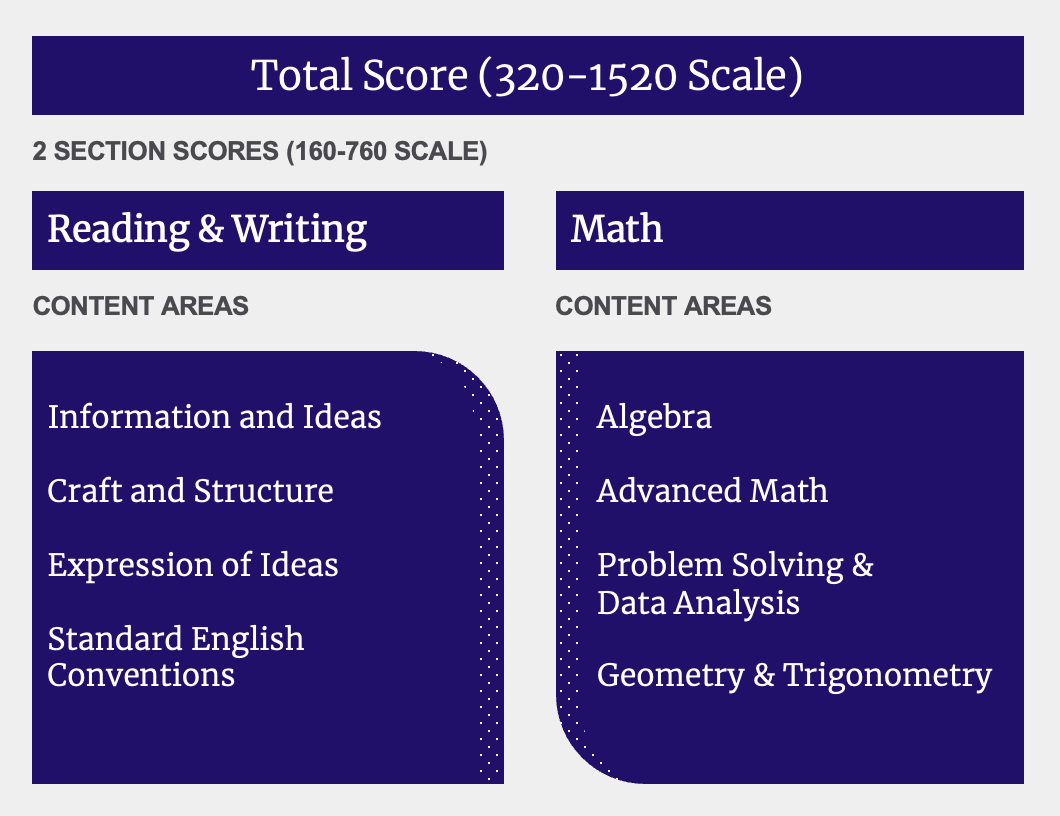
Doing well on the first module, also known as the routing module, will send you to a higher difficulty second module. This will give you a chance to earn the very top scores for a section (either Reading and Writing or Math). Bear in mind that even if you are routed to an easier second module, you can still earn a competitive score on the PSAT. Don’t spend time trying to figure out which difficulty level you were routed to; this will only waste your brainpower and time. Your focus should be to do your best on every question, regardless of which module it is in.
The PSAT also gives you a percentile ranking, which allows you to compare your scores with those of other test-takers. For example, a student who scored in the 63rd percentile did better than 63 percent of all others who took that test.
When and where do I take the PSAT?
The PSAT/NMSQT is offered every October. This year, the testing window is October 2–October 31, 2023; schools will administer the exam on a school day within this window. There is a Saturday testing option on October 14, 2023 that some schools may choose. The PSAT is administered at your high school, not at a testing center. Homeschooled students can sign up at a participating local high school. Some high schools recommend that their sophomores take the test for additional practice, but sophomores who take the PSAT are not eligible to qualify for the National Merit Scholarship unless they are in an accelerated program and are preparing to graduate the following year. However, some schools will administer the test to their students only once (at the beginning of junior year). If this is the case, sophomores wanting to take the PSAT need to get permission from their guidance counselors.
Why should I take the PSAT?
The PSAT is also known as the Preliminary SAT, and is a practice version of the SAT. You can use your results from the PSAT to predict your score on the SAT or the ACT . Your performance on the PSAT can also give you insight on how to structure your study plan for the SAT or ACT and help you pinpoint areas on which you need to focus. Additionally, taking the PSAT can lead to more money for college through the National Merit Scholarship Program. Your PSAT scores are automatically submitted for consideration, and you may be selected as a National Merit Scholarship Finalist and ultimately receive an award.
Getting ready to take the PSAT? Check out our study plan.
You might also like

Call 1-800-KAP-TEST or email [email protected]
Prep for an Exam
MCAT Test Prep
LSAT Test Prep
GRE Test Prep
GMAT Test Prep
SAT Test Prep
ACT Test Prep
DAT Test Prep
NCLEX Test Prep
USMLE Test Prep
Courses by Location
NCLEX Locations
GRE Locations
SAT Locations
LSAT Locations
MCAT Locations
GMAT Locations
Useful Links
Kaplan Test Prep Contact Us Partner Solutions Work for Kaplan Terms and Conditions Privacy Policy CA Privacy Policy Trademark Directory
Parents Guide to PSAT 10
College Board
- February 13, 2024
The PSAT 10 is part of the SAT Suite of Assessments and is taken in the spring by students in 10th grade.
Questions on the PSAT 10 are structured similarly to those on the SAT, focusing on the reading, writing, and math skills your teen is learning in school. See what’s on the PSAT 10 test.
Beginning in spring 2024, the PSAT 10 is digital. Find out what to expect .
Why the PSAT 10 is important
The PSAT 10 is more than good practice for the PSAT/NMSQT and SAT. The insights gained can help power your teen’s path to college and career. With your teen’s results, they can:
- Have new ways to access their scores : Your teen can receive scores quickly and directly through the BigFuture® School mobile app . They may also receive a PDF score report from their school.
- See where they are and set a target: Your teen will receive insights about their knowledge and skills while they still have plenty of time to improve. If they’ve taken other assessments in the SAT Suite, they can compare their progress and then set a target SAT score based on their goals.
- Find out about their likelihood to succeed in AP: Using their personalized score report, your teen will get recommendations about which AP courses might be a good fit for them.
- Gain career insights: Beginning in 2024, the personalized career information on the score report aims to spark interest in careers. Students can choose to log on to BigFuture for in-depth exploration .
The PSAT 10 is the same as the PSAT/NMSQT in terms of subject matter and difficulty, but it’s different from the PSAT/NMSQT in two ways:
- Students take it in the spring of 10th grade, instead of the fall of 10th or 11th grade.
- It doesn't qualify students for the National Merit Scholarship Program .
- The PSAT is given in March or April. Schools may offer the test to different groups of students at different times during the testing window.
- The PSAT 10 and the PSAT/NMSQT both have a score range of 320–1520. Learn more about PSAT 10 scores.
- All four tests in the SAT Suite of Assessments measure the same knowledge and skills students need for college in ways that make sense for each grade level. Read more about the SAT Suite.
- PSAT 10 testing accommodations are available for students with disabilities. See how to request accommodations for your child.
- Taking the PSAT 10 doesn't qualify students for the National Merit Scholarship Program.
- Some schools charge students a fee to take the PSAT 10, but many don't. There are no PSAT 10 fee waivers .
Frequently Asked Questions
Can ninth graders take the psat 10.
Yes. Any student can arrange to take the PSAT 10 at a school that offers it. However, we recommend eighth and ninth graders take the PSAT 8/9. The PSAT 8/9 tests the same skills and knowledge as the PSAT 10 but in a way that's appropriate for eighth and ninth graders.
Do students have to write an essay on the PSAT 10?
No, the PSAT 10 does not have an essay.
Can homeschooled students take the PSAT 10?
Yes. Homeschooled students can contact a local school and arrange to take the PSAT 10 there. Search for schools that are planning to administer the PSAT 10 this school year .
Related Posts
College Planning
How to Start Planning for College in 10th Grade
Calculate for all schools
Your chance of acceptance, your chancing factors, extracurriculars, what's the psat and when should i take it.
Hey everyone! I'm a junior and keep hearing about the PSAT but I'm not totally clear on what it is or when I'm supposed to take it. Is there a specific year it's meant for, and what does it actually test you on? Also, how does it differ from the SAT?
Hi there! The PSAT, or Preliminary SAT, is essentially a practice version of the SAT. It's also known as the National Merit Scholarship Qualifying Test (NMSQT) for juniors. While the content and structure are very similar to the SAT, it's a bit shorter and doesn't include an essay section. High school students usually take the PSAT in the fall of their junior year, which is the official year you can qualify for the National Merit Scholarship Program. Sophomores can also take it as practice, but their scores won't count for the scholarship competition.
The PSAT tests you on reading, writing, and math, just like the SAT, and it's a great way to get a feel for the kind of questions you'll encounter on the SAT. Additionally, since it's aligned with the SAT, the PSAT can help identify areas you need to work on before taking the SAT. It's different in that it's shorter, scores are used primarily for scholarship qualification, and it's not used for college admissions purposes. Make sure you check with your school for specific test dates and sign-up information for this academic year. Best of luck prepping for the PSAT!
About CollegeVine’s Expert FAQ
CollegeVine’s Q&A seeks to offer informed perspectives on commonly asked admissions questions. Every answer is refined and validated by our team of admissions experts to ensure it resonates with trusted knowledge in the field.

- FREE RESOURCES
- REQUEST MORE INFO

- Call 1-87STUDYPOINT
- STUDENT LOGIN
- ACT Tutoring
- SAT Tutoring
- Math Tutoring
Academic Tutoring
Admissions support.
- Free Resources

- PSAT Tutoring
- SSAT Tutoring
- ISEE Tutoring
- AP Tutoring
- Elementary Math
- 6th Grade Math
- 7th Grade Math
- 8th Grade Math
- Pre-Algebra
- Algebra Tutoring
- Geometry Tutoring
- Algebra 2 Tutoring
- Precalculus Tutoring
- Trigonometry Tutoring
- Calculus Tutoring
- Homework Help
- Biology Tutoring
- Chemistry Tutoring
- Physics Tutoring
- Spanish Tutoring
- French Tutoring
- Writing (Academic)
- Writing (Creative)
- Study Skills Support
- Reading Tutoring
- College Essay Coaching
- College Counseling
- Private School Admissions Counseling
- Boarding School Admissions Counseling
PSAT Writing and Language - An Overview of the PSAT Writing and Language Section
The PSAT Writing section consists of a total of 44 multiple-choice questions to be answered in 35 minutes. The Writing section asks you to read passages, find mistakes and/or weaknesses, and fix them. Below you can find more detailed information about the specific skills these questions test.
| Type of Question | Skills/Content Tested |
|---|---|
| Command of Evidence | Asked to improve the way passages develop information and ideas. For example, choose an answer that sharpens an argument's claim or adds relevant supporting details. |
| Words in Context | Make a passage more concise or precise, improve syntax, style or tone by choosing the best words to use in a sentence or paragraph. |
| Specific Subject Area Analysis | Read passages about topics in history, social studies, and science. Then, make editorial decisions on how to improve them. |
| Expression of Ideas | Assess a passage's organization and impact by choosing which words or structural changes improve how the paragraph makes it's point. |
| Standard English Conventions | Tested on the building blocks of writing: sentence structure, usage, and punctuation. Topics include verb tense, parallel construction, subject-verb agreement, and comma use. |
To access sample Writing questions, visit the College Board website .
Related Topics
- For more information about the PSAT Reading sections, visit our PSAT Reading page.
- For more information about the PSAT Math sections, visit our PSAT Math page.
- To learn how the PSAT is scored, visit our PSAT Scores page.
- Looking for PSAT test dates? Visit our PSAT Test Dates page.
- Wondering how PSAT scores are calculated? Visit our PSAT Scores page to find out.
- Wondering how a student qualifies for the National Merit Scholarship? Visit our National Merit Scholarship Qualifications page.
Share This Information:
StudyPoint is a national leader in one-to-one, in-home test prep and academic tutoring. The test-taking techniques and strategies taught in our SAT tutoring and ACT tutoring programs enable students to earn higher test scores and gain admission to competitive colleges and universities. Our expert subject tutors and personalized lesson plans help students earn better grades and become happier, more confident students. Whether you're looking for a math tutor , or any other type of academic tutoring , StudyPoint can help. To learn about tutoring programs in your area, feel free to contact us for more information.
About StudyPoint
StudyPoint offers private, in-home SAT, PSAT, ACT & SSAT tutoring. Our staff also includes expert math, science, foreign language, and writing tutors.

- Preparing For College
- College Applications
- Supporting Your Student
- Guidance Counselors
- College Selection
- College Selection Process
- PLAN Test Info
- Transitions Program Info
Download for free!
Parent's guide to college admission.

Our newsletter is designed to offer you grade- and season- specific information that will help you navigate and stay on top of the college admissions process. We need high school graduation year to provide you with timely, relevant information. You can unsubscribe at any time.

Request More Info
If you'd like to learn more about one of our programs or are ready to enroll your child in tutoring, please contact us. Our Enrollment Consultants are experts in their fields and would be happy to help with recommendations for tutoring programs, courses of study, standardized tests, and admissions support.
1-87STUDYPOINT
You have successfully requested more information.
Thank you for your interest in our programs!
You can expect one of our Enrollment Directors to be in touch within one business day.
If you have an urgent tutoring need, you can reach out to a member of our staff directly at 1-87STUDYPOINT (1-877-883-9764). We are certain we can be a resource for you and your family this school year, and we look forward to speaking with you!
—The StudyPoint Staff
Our Privacy Policy: we are a professional service and we take our clients' privacy seriously. None of this information will ever be shared or sold.

Choose Your Test
Sat / act prep online guides and tips, psat vs sat: 6 key differences you must know.
PSAT Info and Strategies , SAT

There's the PSAT, there's the SAT. There are even a few other assessments, as it turns out. There's a lot of jargon out there when it comes to the tests offered by the College Board, so it's important to know exactly what you're signing up for—and how each test is different.
The SAT suite of assessments is designed to work together. All tests are fundamentally similar, and you can use any one to prepare for any other. That being said, the PSAT vs SAT isn't a perfectly equal match-up. In reality, there are some differences—both major and minor—between them. We take a look at these below.
The SAT Suite of Tests: Overview
First things first, let's establish what College Board tests are actually out there and what these tests' often confusing monikers actually mean.
This test is taken in 8th and/or 9th grade to indicate what areas need special attention before a student graduates high school.
This test is exactly identical to the PSAT/NMSQT (discussed below); however, it's only offered in the spring and is only open to students in the 10th grade.
This test, taken in the fall of 10th and/or 11th grade , is another check-in point meant to point out any skills a student has yet to master. Notably, though, it also gives students a chance to qualify for the National Merit Scholarship .

The college admission test we all know and love, the SAT indicates your college readiness to any schools receiving your application .
From here on out, we're going to zero in on the two tests that do most of the heavy lifting: the PSAT/NMSQT (hereafter referred to simply as the PSAT) and the SAT.

PSAT vs SAT: What's the Same?
The content and format of the SAT and PSAT are very similar, though not identical. Before we get into the key differences, let's talk about what doesn't change from one test to the other.
#1: Content
These two tests cover the same subjects. I mean, exactly the same subjects —it's even a bit eerie. There's algebra on the PSAT; there's algebra on the SAT . There are vocab-in-context questions on the PSAT, and there are vocab-in-context questions on the SAT , too. You get the picture.
#2: Basic Structure
The style of the questions doesn't change much from one test to the other, either in terms of wording or the actual tasks. Also, the overall structure and global goal of testing remain the same.
Both tests have two major components: Evidence-Based Reading and Writing (EBRW), and Math (the SAT also has an optional Essay component —more on that below). EBRW includes the Reading Test and the Writing and Language Test, whereas Math is made up of two subsections: one allows the use of a calculator, and the other one does not.
On both the PSAT and the SAT, you'll get passages on the Reading and Writing sections. On the Reading section you'll answer reading comprehension questions, and on the Writing section you'll answer questions about how to fix grammatical and stylistic weaknesses in the text.
In addition, both the PSAT and SAT Math sections contain grid-in questions as well as multiple-choice questions. The grid-in questions come at the end of each section.
#3: Subscores and Cross-Test Scores
In addition to your final composite score, you'll always receive cross-test scores and subscores on the PSAT and SAT. However, t here's a division between Math and EBRW, and there are a few other specifications, too.
The two cross-test scores are Analysis in History/Social Studies and Analysis in Science. These scores refer to every question that tests critical thinking in the named areas, whether appearing in a verbal section or the qualitative one.
As for subscores, these differ for each of the three sections on the PSAT and SAT.
The Reading section uses the following subscores:
- Command of Evidence
- Words in Context
The Writing and Language section gives us these subscores:
- Expression of Ideas
- Standard English Conventions
And finally, the Math section's subscores are as follows:
- Heart of Algebra
- Problem Solving and Data Analysis
- Passport to Advanced Math
#4: No Guessing Penalty
In the olden days, answering a question wrong meant having points literally deducted from your score. One-quarter point per question, to be exact.
So if you missed eight questions, not only would you not get those eight points, but you'd also lose an extra two points. Those two points would be subtracted from the points you'd already earned.
Fortunately, those dark days are over. Today, if you miss eight questions on either the PSAT or SAT, all you lose is the opportunity to earn those eight points. Nothing gets subtracted from your score!
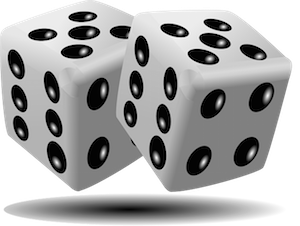
PSAT vs SAT: What's Different?
Now that we've covered the similarities between the two tests, let's dig into the differences.
#1: Purpose
The first major difference is the purpose of each test. Whereas the SAT is a common requirement for college admissions, the PSAT is an SAT practice test and the basis for the National Merit Scholarship Program . In other words, since the PSAT is essentially a precursor to the SAT, it is not as important as the SAT is.
In regard to colleges, the PSAT has no impact on your admission chances, while the SAT typically does. Even a super low score on the PSAT would have no effect on your college applications. By contrast, a super low SAT score would likely significantly lower your admission chances.
With National Merit, you can only enter the competition if you get in the top 1% of scorers on the PSAT (and are a high school junior). Thus, while a top 1% SAT score would no doubt give a boost to your college applications, it would not make you eligible for National Merit.
#2: Score Range
The PSAT is scored on a scale of 320-1520 , while the SAT is scored on a scale of 400-1600 .
This means that the individual section score ranges differ as well. On the PSAT, EBRW and Math are each scored on a scale of 160-760. On the SAT, however, these sections are scored on a slightly bigger scale of 200-800.
Your PSAT score is meant to directly predict your SAT score. So if you get 1200 on the PSAT, you can expect to get roughly the same score if you took the SAT without further preparation.
Why the different score ranges, though? Because the PSAT is a little less challenging (so as to accommodate a lower grade level), a perfect score on the PSAT falls a little short of a perfect score on the SAT .
It's also important to note that the amount of time and the number of questions for each section differ between the two tests. The SAT is slightly longer and has more questions, but the amount of time allotted per question is generally the same.
The only exception is the Math No Calculator subsection, for which you get 13 seconds more per question on the PSAT than you do on the SAT.
Here's an overview of the time and question differences between the PSAT and SAT:
| Reading | 60 minutes | 48 | 75 seconds | |
| Writing | 35 minutes | 44 | 48 seconds | |
| Math No Calc | 25 minutes | 17 | 88 seconds | |
| Math Calc | 45 minutes | 31 | 87 seconds | |
| 165 minutes | 139 | — | ||
| Reading | 65 minutes | 52 | 75 seconds | |
| Writing | 35 minutes | 44 | 48 seconds | |
| Math No Calc | 25 minutes | 20 | 75 seconds | |
| Math Calc | 55 minutes | 38 | 87 seconds | |
| Essay (optional) | 50 minutes | 1 | 50 minutes | |
If you skip the essay, the SAT is only 15 minutes longer. But if you do take the essay—which is probably wise—you're in for an extra hour of testing. You'll want to train your endurance toward that goal.
#4: The Essay
You'll note that there was actually more than just a matter of timing implied in that last section. That's right: the PSAT has no essay.
The SAT, on the other hand, does. It's optional , so you don't have to take it. But as your colleges might require or recommend it, you should be aware that this is one aspect of the SAT that the PSAT won't prepare you for. As a result, make sure you give the essay some attention before you dive into the SAT.

#5: Level of Difficulty
Throughout the College Board's suite of tests, things get a little bit harder. It's nothing huge; you just might find that the PSAT has more concrete, find-this-detail-in-the-text questions while the SAT has more abstract, what-purpose-did-this-detail-serve sorts of questions.
#6: Logistics
The final difference lies in the logistics of the PSAT and SAT, namely how each test is administered, how much each test costs, and where you can take each test.
In terms of administration, the PSAT is held just once a year in October , while the SAT is offered seven times throughout the school year . (You can also take the SAT on a designated school-day test day .) As you can see, you're typically expected to take the PSAT just once or twice in total. With the SAT, however, you have far more options to retake it and raise your score.
Another big logistical difference is price. Though the PSAT is sometimes free for students whose schools cover the full cost of the test, the typical price is $16 a test. Comparatively, the SAT costs $46 without the Essay and $60 with the Essay . (Note that fee waivers are available for both the PSAT and SAT .)
Finally, while the PSAT is always administered at schools, the SAT is administered at both schools and test centers. So if you're homeschooled or if your school doesn't offer the PSAT, you'll need to find another local school at which you can take it .
PSAT vs SAT: Key Takeaways
It's always a good idea to throw in a full-length, official practice PSAT before you take the real thing.
If you're preparing for the PSAT using an SAT program , the good news is that you'll likely be overly prepared in terms of comfort with the content and your overall endurance. What you'll need to watch out for, though, is a probable tendency to overanalyze the slightly simpler questions on the PSAT. Know that you will not be writing an essay on the PSAT, either.
If you're preparing for the SAT using the PSAT, bear in mind that though it will get you most of the way there, you'll still need to supplement your study program with official practice SAT questions and at least a few cracks at the essay .
What's Next?
Prepare for the task ahead of you, whether it be the PSAT , the SAT , or both. It's important to be familiar with what you'll be doing on test day. And practice, as they say, makes perfect.
Set some good goals —find out what it takes to qualify for the National Merit Scholarship Program , and learn what a good PSAT score looks like . That's actually not a simple question to answer, but reading up on the subject will get you feeling more comfortable with what you should aim for!
If it's too early to think about the PSAT or the SAT, read some carefully considered advice about taking the PSAT 8/9 .

Vero is a firsthand expert at standardized testing and the college application process. Though neither parent had graduated high school, and test prep was out of the question, she scored in the 99th percentile on both the SAT and ACT, taking each test only once. She attended Dartmouth, graduating as salutatorian of 2013. She later worked as a professional tutor. She has a great passion for the arts, especially theater.
Ask a Question Below
Have any questions about this article or other topics? Ask below and we'll reply!
Improve With Our Famous Guides
- For All Students
The 5 Strategies You Must Be Using to Improve 160+ SAT Points
How to Get a Perfect 1600, by a Perfect Scorer
Series: How to Get 800 on Each SAT Section:
Score 800 on SAT Math
Score 800 on SAT Reading
Score 800 on SAT Writing
Series: How to Get to 600 on Each SAT Section:
Score 600 on SAT Math
Score 600 on SAT Reading
Score 600 on SAT Writing
Free Complete Official SAT Practice Tests
What SAT Target Score Should You Be Aiming For?
15 Strategies to Improve Your SAT Essay
The 5 Strategies You Must Be Using to Improve 4+ ACT Points
How to Get a Perfect 36 ACT, by a Perfect Scorer
Series: How to Get 36 on Each ACT Section:
36 on ACT English
36 on ACT Math
36 on ACT Reading
36 on ACT Science
Series: How to Get to 24 on Each ACT Section:
24 on ACT English
24 on ACT Math
24 on ACT Reading
24 on ACT Science
What ACT target score should you be aiming for?
ACT Vocabulary You Must Know
ACT Writing: 15 Tips to Raise Your Essay Score
How to Get Into Harvard and the Ivy League
How to Get a Perfect 4.0 GPA
How to Write an Amazing College Essay
What Exactly Are Colleges Looking For?
Is the ACT easier than the SAT? A Comprehensive Guide
Should you retake your SAT or ACT?
When should you take the SAT or ACT?
Get Informed
Get the latest articles and test prep tips!

Looking for Graduate School Test Prep?
Check out our top-rated graduate blogs here:
GRE Online Prep Blog
GMAT Online Prep Blog
TOEFL Online Prep Blog
Holly R. "I am absolutely overjoyed and cannot thank you enough for helping me!”
College Reality Check
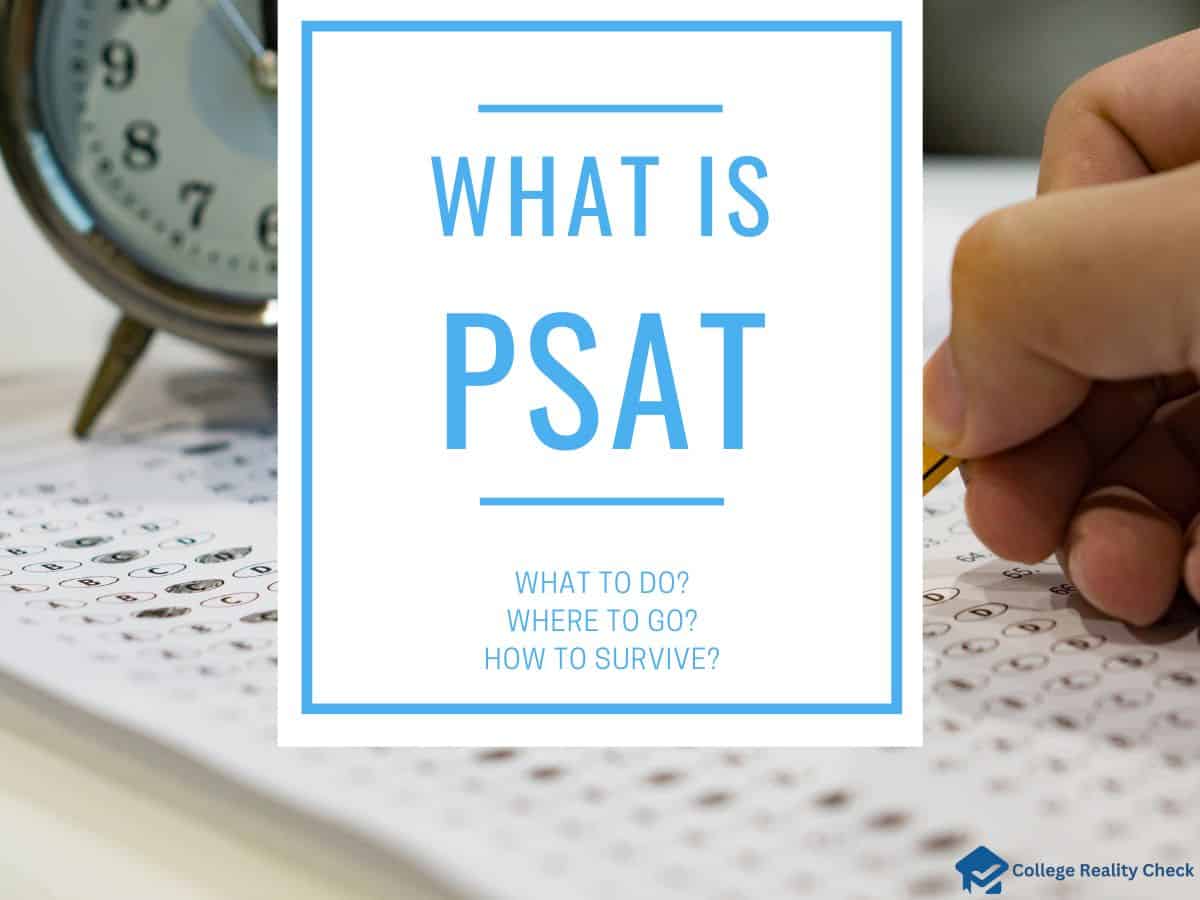
What is the PSAT? Practice Test Included
The PSAT stands for Preliminary Scholastic Aptitude Test. Administered by the College Board, it’s a standardized test that helps high school students prepare for a major college entrance exam and a prestigious merit-based scholarship.
Created as a practice test for high schoolers who are planning on taking the SAT, the PSAT helps boost college admissions chances by improving SAT performance. In addition, the PSAT serves as a qualifying exam for college-bound teens who are interested in winning the National Merit Scholarship Program.
This post contains some of the most essential things you need to know about the PSAT.
Is the PSAT Important for College Admissions?
The PSAT is not an important standardized test for college admissions. That’s because it’s not considered as one of those college admissions tests such as the SAT and ACT that test-required and test-optional institutions take into account in the admissions process. As a matter of fact, the College Board does not send PSAT scores to colleges.
While the PSAT won’t have a direct impact on your chances of getting an acceptance letter from your top-choice school, it can, however, determine your eligibility for the National Merit Scholarship.
Do You Have to Take the PSAT?
Some high schools require students to take the PSAT, and most of them take care of the registration fee, too. Otherwise, it’s completely up to the high schooler to decide whether or not they will sit for the PSAT.
However, being the PSAT/NMSQT, those who wish to apply for the National Merit Scholarship Program should take the standardized test in the 11th grade.
It may be a practice test for the SAT alright, but the PSAT is not a prerequisite for taking the SAT.
Read Also: 13 College Entrance Exams And When To Take Them
Can Colleges See How Many Times You Took the PSAT?
Colleges cannot see how many times applicants took the PSAT. Other than not being an important part of the college admissions process, the College Board does not send PSAT scores to institutions of higher education. Throughout their high school careers, teens can only take the PSAT, which is administered only once a year, up to 3 times.
For high schoolers who like to boost their chances of winning the National Merit Scholarship, taking the PSAT 1 or 2 times before their junior year may be done. It can also help increase their SAT scores and, ultimately, college admissions chances.
What is on the PSAT?
The components of the PSAT are the very same components of the SAT. After all, it serves as a practice test for the SAT. While it’s made up of 3 tests, there are only 2 primary sections of the PSAT: the Evidence-Based Reading & Writing (EWRB) and Math sections. However, unlike in the SAT, test-takers will encounter a few write-in questions, too, in the PSAT.
According to the PSAT website itself, some of the math questions will require you to write an answer instead of choosing it.

How Many Sections are on the PSAT?
The 2 main sections of the PSAT are the EWRB section and the Math section. The EBRW section is made up of Reading and Writing & Language. The Math section, on the other hand, consists of 2 sub-sections: the no-calculator section and the calculator-optional section. There is no optional Essay section on the PSAT, such as the case with the SAT in the past.
Even though the PSAT is a slightly shorter and slightly easier version of the SAT, therefore making it a practice test, both standardized tests are pretty much similar. And that is why the PSAT can help prepare you better for the SAT.
How Many Questions is the PSAT?
The PSAT has a total of 139 questions — the vast majority of them are multiple-choice questions, while a few of them, which are found in the Math section of the PSAT, are write-in questions. Of all the sections, the Math section has the most number of questions. The Writing & Language component of the EWRB section, meanwhile, has the least number of questions.
Here’s a table showing the number of questions each section of the PSAT has:
| Reading | 47 |
| Writing & Language | 44 |
| Math | 48 (31 for the calculator-optional section and 17 for the no-calculator section) |
What Kind of Math is on the PSAT?
The Math section of the PSAT focuses on various areas of mathematics that play the biggest role in numerous academic majors and minors. The College Board refers to the various types of math included in the PSAT as Heart of Algebra, Problem Solving and Data Analysis, Passport to Advanced Math and Additional Topics in Math.
Below is a description of the math kinds you will encounter when sitting for the PSAT:
- Heart of Algebra – knowledge of linear equations and systems
- Problem Solving and Data Analysis – problem analysis and obtaining information from data
- Passport to Advanced Math – questions involving the manipulation of equations
- Additional Topics in Math – college-relevant geometry and trigonometry
Is There Science on the PSAT?
Even though there is no section on the PSAT that’s dedicated to science, some passages are science-related. For instance, the Reading portion of the EBRW section has either 1 or 2 science passages as well as a set of paired science passages, all of which contain a lot of technical terms and jargon that set them apart from other passages.
Both the PSAT and SAT do not have any science sections. On the other hand, the ACT has a science section, which makes it more appealing to some high school teens who consider science as their strength.
Is There Writing on the PSAT?
The PSAT has a Writing section, which is a part of the Writing & Language component of the EBRW section. The Writing section requires test-takers to read passages and then find mistakes and/or weaknesses and correct them. Despite the name, the Writing section contains multiple-choice questions and does not require students to write something.
An argument, informative or explanatory text, or a nonfiction narrative — these are the kinds of passages you will have to carefully read to answer the questions in the PSAT’s Writing section.
How Does the PSAT Work?
In this part of the post, we will discuss various things related to taking the PSAT, including how your test will be scored and what score you should get to impress colleges and qualify for the National Merit Scholarship.
What Does the PSAT Measure?
The PSAT is structured very similarly to the SAT, for which it serves as a practice test. It goes without saying that the PSAT is designed to measure the same things that the SAT is meant to measure. They are reading, writing and math skills that high school students learn in the classroom, all of which are necessary for college and career success.
Because the PSAT can be taken in as early as the 9th grade, the PSAT cannot necessarily determine a student’s college readiness. However, it can help ascertain whether or not a teen is on the right track through grade-level benchmarks.
Is the PSAT Multiple Choice?
Most of the questions on the PSAT are multiple-choice kinds, and each multiple-choice question is accompanied by 4 answer choices. While there are multiple-choice questions in the Math section of the PSAT, some of them require test-takers to write in their answers rather than select them. All in all, there are 8 write-in questions on the PSAT.
Questions where students have to provide their responses are also referred to as grid-in questions or simply grid-ins as they need to enter their answers in the grids found on the answer sheet.
Is the PSAT a Standardized Test?
The PSAT is a standardized test because it is given to high schoolers in a consistent or standard fashion. This means that all the questions on the test are all the same for all students no matter which high school they are attending.
Also making the PSAT a standardized type of examination is the fact that it’s scored the same for all those who take it.
Being the PSAT/NMSQT, the PSAT is also a standardized eligibility exam for the National Merit Scholarship.
When Do You Take the PSAT Test?
Most high school students take the PSAT in the 11th grade. Other than giving them practice for the SAT, it also enables them to be considered for the National Merit Scholarship Program.
However, the PSAT can also be taken during the freshman and sophomore years of high school, but it won’t serve as a qualifying exam for the National Merit Scholarship.
There is no use for any high schooler to take the PSAT in the 12th grade.
How to Guess on the PSAT
The right way to guess on the PSAT is to eliminate at least 1 incorrect answer among the answer choices, which gives the test-taker 1 in 3 chances of making the right guess. On the other hand, eliminating 2 incorrect answers among the answer choices makes it possible for the student taking the PSAT to get the right answer on a 50/50 basis.
Because there is no wrong-answer penalty on the PSAT, it’s generally a good idea for high schoolers who don’t know the answer to make a guess instead of leaving a question unanswered.
How Long is the PSAT?
It takes 2 hours and 45 minutes (with breaks) to complete taking the PSAT. Test-takers are given 70 minutes to complete the Math section, which has a total of 48 questions — 31 questions for the calculator-optional section and 17 questions for the no-calculator section.
Meanwhile, students have up to 95 minutes to complete the EBRW section, which has a total of 91 questions.
Here’s a table showing the breakdown of the PSAT’s testing time:
| Reading | 60 minutes |
| Writing & Language | 35 minutes |
| Math | 70 minutes |
How Does PSAT Scoring Work?
Each section of the PSAT is scored on a scale of as low as 160 to as high as 760. The scores test-takers get in both sections of the standardized test are added, resulting in their PSAT composite score. So, in other words, the overall PSAT score can range anywhere from 320 to 1520, which may help predict the SAT composite scores of a test-taker.
There is no such thing as a failing score on the PSAT.
What is a Good PSAT Score?
Generally speaking, a good PSAT score is a composite score of 1070 or higher, which puts the high school student in the top 25% of all test-takers. An excellent score, which is between 1210 and 1520, puts the teen in the top 10% of all test-takers. For eligibility for the National Merit Scholarship Program, a student must be in the top 1% of all test-takers.
Other than increasing your chances of getting an SAT composite score that can help you get into your top-choice college, getting a high PSAT score can also make it possible for you to win the National Merit Scholarship.
Facts About the PSAT
Let’s talk about some important matters you need to know about the PSAT, including its beginnings, how many high school students take it every year and whether or not it comes with an optional Essay section.
History of the PSAT
The PSAT, like the SAT, was created by the College Board. It was in 1959 when the PSAT was administered for the very first time.
In 1971, the National Merit Scholarship Program, which is a US academic scholarship competition for recognition and university scholarships and is not related to the College Board, adopted the PSAT as its qualifying examination.
More than 30 years after the SAT came into being, the PSAT was administered to help high school students prepare for the SAT. In the past, some intellectual clubs used PSAT scores in admitting new members.
Who Created the PSAT?
It was the College Board that designed the PSAT, whose goal was to serve as a preliminary exam for the SAT. The non-profit organization decided to come up with the standardized test to provide high school students with the opportunity to prepare for the SAT and thus allow them to increase their chances of getting admitted to college.
Eventually, as mentioned earlier, it was used as a qualifying test for the National Merit Scholarship.
What is the College Board?
The College Board is an organization that designs and administers standardized tests as well as develops curricula for use by K-12 and institutions of higher education for the promotion of college readiness. The non-profit was established in 1900 by representatives of a total of 13 academic institutions at the University of Columbia.
Although it’s not an association of colleges, many postsecondary institutions are members of the College Board. As of this writing, there are more than 6,000 schools that are approved members.
How Many People Take the PSAT?
Around 3.5 million high school students take the PSAT. They consist of sophomore and junior high schoolers across the US. The College Board itself says that in the academic year 2021 to 2022, around 3.6 million students took the PSAT.
Meanwhile, over 1.5 million entrants for The National Merit Scholarship Program who meet other requirements take the PSAT.
More high schoolers take the SAT than the ACT. It’s therefore safe to assume that more students also take the PSAT than the PreACT, which is the counterpart of the PSAT.
What is the PSAT Designed to Predict?
The PSAT is designed to predict the SAT scores of high school students and, ultimately, their college readiness given that the SAT is primarily designed for such a purpose.
By taking the PSAT, test-takers know their strong points and, more importantly, their weak spots so that they can take the necessary steps to prepare for the SAT and get good scores.
Want to have an idea of how you may score on the SAT based on your PSAT scores? Online, you can easily access PSAT to SAT conversion tools and charts, most of which are free of charge.
Does the PSAT Have an Essay?
There is no Essay section of the PSAT. The standardized test has 2 main sections, the EBRW section and Math section, and nothing else. In the past, the SAT used to have an optional Essay section but the College Board decided to stop offering it altogether.
On the other hand, the PSAT never had an optional Essay section from the get-go.
Preparing for the Essay section on the SAT by means of an Essay section on the PSAT is completely pointless given that the said section of the SAT became optional in 2016 and unavailable in 2021.
Does the PSAT Provide Calculators?
The PSAT does not provide test-takers calculators. High school students who are sitting for the PSAT must bring their own approved calculators with them to their respective high schools, where the PSATs are administered. Similarly, test-takers are not allowed to share calculators and use them on the Math no-calculator portion and EBRW portion.
Here’s a list of all allowed calculator models from the College Board itself.
PSAT is Changing – Paper Based vs. Digital
The PSAT will be administered in digital format, and its paper and pencil format will cease to exist.
Since it was first taken by students preparing for the SAT back in 1959, it underwent 3 major changes in its format and content as well as how it’s scored. The said changes happened in 1997, 2005 and 2015.
In the fall of 2023, the PSAT will once again go through a significant change in that it will be administered in digital format.
The College Board chose the said date so that high school students who will be taking the digital SAT as juniors in the spring of 2024 will have the opportunity to experience what it’s like to take the standardized test in its entirely new format.
The National Merit Scholarship Program will still use the digital PSAT as its qualifying exam.
When Does the PSAT Go Digital?
As mentioned earlier, the PSAT will go digital in the fall of 2023. From that time onward, the paper and pencil format of the PSAT will no longer be made available by the College Board.
How to Study for the PSAT
According to the PSAT website itself, studying for the standardized test requires making a study plan, creating a realistic goal, taking practice tests and targeting areas that require improvement.
It’s a good thing that free PSAT test preps are available from the College Board and various sources, too.
Undergoing practice tests when preparing for the PSAT is an important step high school teeners should take. Not only will it allow them to become familiar with the PSAT exam experience but also enable them to determine areas that require more attention. This way, they can quit wasting time reviewing things they already know.
It’s recommended to start gearing up for the PSAT about 3 months before the test date. However, it’s a smart move to start preparing for it, which is administered every October of the year, at the start of the school year.
PSAT Practice Test
In this part of the post, I will give you a total of 10 sample PSAT questions — 5 of them are from the Writing & Language portion of the EWRB section, while the other 5 are from the Math section.
Let’s start with a short reading passage:
Vanishing Honeybees: A Threat to Global Agriculture
Honeybees play an important role in the agriculture industry by pollinating crops. An October 2006 study found that as much as one-third of global agriculture depends on animal pollination, including honeybee (12) pollination — to increase crop output. The importance of bees (13) highlights the potentially disastrous affects of an emerging, unexplained crisis: entire colonies of honeybees are dying off without warning.
(14) They know it as colony collapse disorder (CCD), this phenomenon will have a detrimental impact on global agriculture if its causes and solutions are not determined. Since the emergence of CCD around 2006, bee mortality rates have (15) exceeded 25 percent of the population each winter. There was one sign of hope: during the 2010–2012 winter seasons, bee mortality rates decreased slightly, and beekeepers speculated that the colonies would recover. Yet in the winter of 2012–2013, the (16) portion of the bee population lost fell nearly 10 percent in the United States, with a loss of 31 percent of the colonies that pollinate crops.
Q 4. Which choice offers the most accurate interpretation of the data in the chart?
Q 5. Which choice offers an accurate interpretation of the data in the chart?
Answer key:
The following, meanwhile, are 5 sample test questions for the PSAT’s Math portion:
1. A soda company is filling bottles of soda from a tank that contains 500 gallons of soda. At most, how many 20-ounce bottles can be filled from the tank? (1 gallon = 128 ounces)
2. A car traveled at an average speed of 80 miles per hour for 3 hours and consumed fuel at a rate of 34 miles per gallon. Approximately how many gallons of fuel did the car use for the entire 3-hour trip?
3. A high school basketball team won exactly 65 percent of the games it played during last season. Which of the following could be the total number of games the team played last season?
4. Janice puts a fence around her rectangular garden. The garden has a length that is 9 feet less than 3 times its width. What is the perimeter of Janice’s fence if the area of her garden is 5,670 square feet?
5. Tyra subscribes to an online gaming service that charges a monthly fee of $5.00 and $0.25 per hour for time spent playing premium games. Which of the following functions gives Tyra’s cost, in dollars, for a month in which she spends x hours playing premium games?
The sample questions above are from the following site: satsuite.collegeboard.org
Should I Take the PSAT?
In some instances, high schoolers have no choice but to take the PSAT, which costs $18, because the schools they are attending require it — most of the time, though, high schools take care of the registration cost.
Otherwise, it’s completely up to the students to decide whether or not to sit for the PSAT.
Taking the PSAT, however, comes with benefits. For instance, since it’s designed as a preliminary exam for the SAT, teens who undergo it can prepare much better for the SAT, thus allowing them to get good scores and increase their college admissions chances. High PSAT scores also allow high schoolers to qualify for the National Merit Scholarship Program.
Read Next: What is SAT?

Independent Education Consultant, Editor-in-chief. I have a graduate degree in Electrical Engineering and training in College Counseling. Member of American School Counselor Association (ASCA).
Similar Posts

Do You Need SAT to Transfer From Community College?
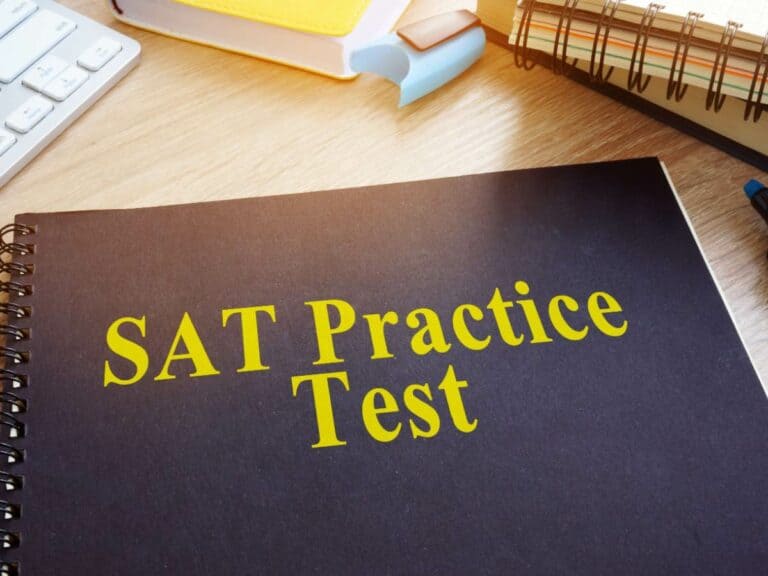
10 Best SAT Practice Tests To Take

Digital SAT vs. Paper Based: Differences and Similarities
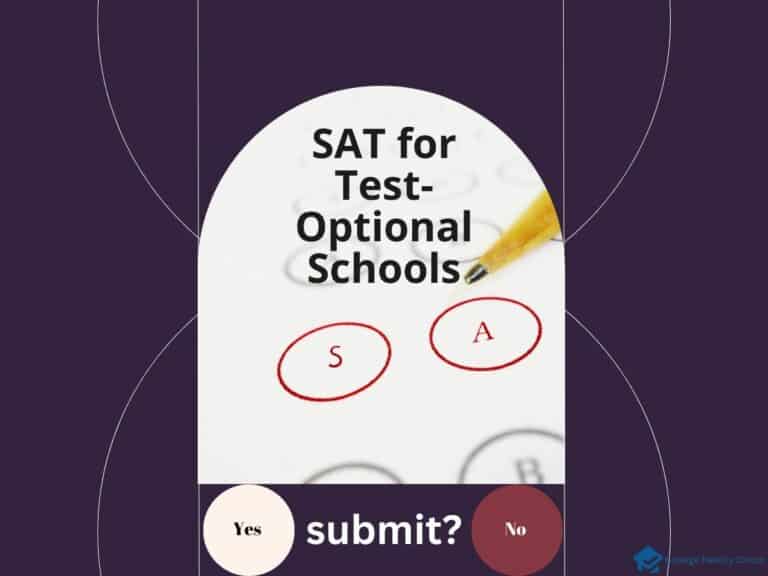
SAT for Test-Optional School: Who and When Should Submit

Are SAT and ACT Still Important in 2023-2024 College Admissions Cycle?

Is It Harder to Get 36 on ACT or 1600 on SAT?

The Admissions Strategist
Psat vs. sat: all the differences you should know.
Students today take a lot of tests. In fact, it’s estimated that the average student in the U.S. takes 112 standardized tests from Pre-K through the end of high school. The exact tests you take depend on where you live and what school you attend. But two tests that just about every U.S. student has heard of are the PSAT and the SAT.
With so many tests on your plate, it’s easy to get confused. What exactly are the PSAT and the SAT? How are they similar? How are they different? In this guide, we’ll tell you everything you need to know about these two important exams.

Click above to watch a video on PSAT vs SAT.
What is the PSAT?
The PSAT, formally known as the Preliminary Scholastic Aptitude Test, is a practice version of the SAT. It’s cosponsored by The College Board and The National Merit Scholarship Corporation.
The 2-hour and 45-minute test assesses reading, writing and language, and mathematics.
Who takes the PSAT?
There are three versions of the PSAT. Most often, people who mention the PSAT are referring to the PSAT/NMSQT. NMSQT stands for National Merit Scholarship Qualifying Test. The PSAT/NMSQT is for high school juniors , and top test-takers may qualify for scholarships and other honors.
The PSAT 10 is for sophomores, and the PSAT 8/9 is given to students in eighth and ninth grades. So, you may take the PSAT as early as eighth grade, then take various versions of the exam through your junior year of high school.
In total, over six million students in the United States take some form of the PSAT annually.
What’s the purpose of the PSAT?
The main purpose of the PSAT is to prepare students for the SAT. Format, test questions, and testing conditions are designed to mirror the SAT, giving you an authentic practice experience.
Students also receive a score report with detailed, useful information about strengths and weaknesses. You can use this info to create a customized SAT study plan.
In the case of the PSAT/NMSQT, the exam can earn you accolades, scholarships, and even full tuition at some colleges.
What is the SAT?
The SAT, or Scholastic Aptitude Test, is designed to measure what you learned in high school and how prepared you are to succeed in college. It provides colleges with a common data point that can be used to evaluate applicants.
It’s a three-hour test (3 hours and 50 minutes if you do the optional essay) that assesses reading, writing and language, and math. Yep, just like the PSAT!
Who takes the SAT?
College-bound high school students take the SAT, typically during their junior year. However, all high school students are eligible to take the test.
About two million high school students sit for the SAT each year.
Why is the SAT important?
The SAT is important because it’s one of the primary metrics that colleges use to assess applicants. Admissions officers will use your SAT score to compare your college readiness to the college readiness of other applicants. They want to admit the students who will be most successful at their school.
Of course, the SAT is not the only factor in admissions decisions . Admissions officers also look at your GPA, strength of schedule, extracurricular participation, letters of recommendation, and personal statement(s). However, the SAT is one of the easiest ways to compare you to the national applicant pool. That’s why at many universities, it’s one of the most significant factors determining admission.
Question Types: SAT vs. PSAT
Now that you know the basics, let’s get into the major differences between the PSAT and the SAT.
When it comes to question types, the two tests are very similar—remember, the PSAT is designed to prepare you for the SAT. On the College Board’s website, in fact, you may notice that the pages describing PSAT and SAT content are nearly identical.
Both tests feature a Reading Test, Writing and Language Test, and a Math Test.
On both the SAT and the PSAT, the reading section consists of passages and multiple-choice questions that test your comprehension and analytical skills. No prior knowledge is tested. All the information needed to answer the questions can be found in the provided passages.
Passages on both tests always consist of:
- One passage from U.S. or world literature
- One passage or a pair of passages related to a U.S. founding document
- One passage related to a social science, including psychology or economics
- Two science passages
Both tests will ask you “command of evidence” questions. For these questions, you’re given four quotes from the passage, then asked to select the quote that provides the best evidence for your answer to the previous question.
You’ll also answer questions about textual analysis and words in context, and you will examine hypotheses and interpret data . Although the questions are similar, those on the SAT will be more challenging.
While the SAT will ask you 52 reading questions, you’ll answer only 47 reading questions on the PSAT.
Get personalized advice!
Writing and language.
The Writing and Language section on both tests includes 44 multiple-choice questions. These questions are passage-based and assess:
- Command of Evidence (Improve the way passages develop claims and ideas)
- Words in Context (Improve word choice)
- Analysis in History/Social Studies and in Science (Make editorial decisions that improve passages on these subjects)
- Expression of Ideas (Make changes that improve the passage’s organization and clarity)
- Standard English Conventions (Questions related to subject-verb agreement, verb tense, comma usage, parallel construction, etc.)
The SAT and PSAT math test is divided into two sections, one that permits a calculator and one that does not. While most questions are multiple choice, some are grid-in.
Questions focus on:
- Heart of Algebra (linear equations and systems)
- Problem Solving and Data Analysis (analyzing quantitative measures and patterns)
- Passport to Advanced Math (manipulating complex equations)
- Additional Topics in Math (geometry and trigonometry)
The PSAT asks 40 multiple-choice math questions and eight grid-ins. The SAT, on the other hand, requires you to answer 44 multiple-choice questions and 13 grid-ins. SAT math questions will cover an additional year of high school mathematics.
Essay: PSAT vs. SAT
One major difference between the PSAT and the SAT is that the SAT offers an optional essay question. The PSAT does not.
SAT test-takers who choose to write the essay have 50 minutes to complete it. Students read a provided passage and explain how the author creates an argument to persuade his or her audience. The explanation must be supported with evidence from the passage.
Although the essay is optional for SAT test-takers, some colleges require it. If you’re taking the SAT and unsure whether you should write the essay, look into application requirements at the schools you’re interested in applying to. If you aren’t sure where you want to apply, it’s smart to write the essay so all your bases are covered.
Scoring: PSAT vs. SAT
The PSAT and the SAT are scored on the same rubric, but a slightly different scale. On the SAT, your total score will fall between 400 and 1600. On the PSAT, the total score range is 320-1520.
Why? The PSAT is designed to directly predict your SAT score. So, if you score a 1320 on the PSAT, you should score around a 1320 on the SAT ( if you don’t do any additional preparation). Because the SAT is more challenging than the PSAT, however, the ranges are slightly different. Someone who lands a perfect score on the PSAT wouldn’t necessarily do the same on the SAT, although they would be expected to perform extremely well.
How are the tests scored?
On both tests, there is no penalty for guessing. That means your raw score is the number of questions you answered correctly. The raw score is then converted to a section score, one score for Evidence-Based Reading and Writing and one score for Math.
Section scores on the SAT range from 200-800. On the PSAT, they range from 160-760. Adding the two section scores together gives you your total score.
Score Reports
But section scores and total scores aren’t the only numbers you’ll see on your score report. You’ll also see the mean (average) scores earned by test-takers around the United States, your percentile rank, and college and career readiness benchmarks. Together, this information presents a clear picture of how prepared you are for college and how your performance compares to the performance of other test-takers.
In addition, you will receive cross-test scores and subscores that indicate your strengths and weaknesses. Cross-test scores include Analysis in History/Social Studies and Analysis in Science.
You’ll see seven subscores:
- Reading and Writing and Language : Command of Evidence and Words in Context
- Writing and Language: Expression of Ideas and Standard English Conventions
- Math: Heart of Algebra, Problem-Solving and Data Analysis, and Passport to Advanced Math
Check out the breakdown of SAT and PSAT score structure below for a clear comparison of score types and score ranges.
Score Structure (SAT)
- Total Score (sum of two section scores): 400-1600
- Section Scores (Evidence-Based Reading and Writing, Math): 200-800
- Test Scores (Reading, Writing & Language, Math): 10-40
- Optional SAT Essay: Three scores ranging from 2-8
- Cross-Test Scores (Analysis in History/Social Studies, Analysis in Science): 10-40
- Subscores: 1-15
Score Structure (PSAT)
- Total Score (sum of two section scores): 320-1520
- Section Scores (Evidence-Based Reading & Writing, Math): 160-760
- Test Scores (Reading, Writing & Language, Math): 8-38
- Cross-test Scores (Analysis in History/Social Studies, Analysis in Science): 8-38
As you can see, both score reports give you a ton of information. The PSAT score report is especially detailed.
You’ll see which questions you missed and which you answered correctly, the difficulty level of each question, the correct answer for each question, and a detailed explanation of the answer. This is an extremely valuable tool as you create an SAT study plan and begin your prep for the big test.
Test Duration: PSAT vs. SAT
The SAT is a slightly longer test than the PSAT, especially if you decide to write the optional essay. Without the essay, the SAT is only 15 minutes longer (2 hours and 45 minutes vs. 3 hours). With the essay, you’ll test for about an hour longer (2 hours and 45 minutes vs. 3 hours and 50 minutes).
In addition to being a longer test, the SAT asks a few more questions than the PSAT. This includes five more questions on the Reading test and 10 more questions on the Math test.
Overall, the amount of time you’ll have per question mostly evens out. The one exception is the Math (No Calculator) section. On the PSAT, you’ll have about 13 seconds more per question on this section than you do on the SAT.
Price: PSAT vs. SAT
Currently, it costs $49.50 to take the SAT without the essay and $64.50 to take the SAT with the essay. If this cost is prohibitive for you and your family, you may be eligible for a fee waiver. The SAT is administered mostly at test centers, but your school may offer the test on-site once a year.
The typical price for the PSAT is $16, but many schools cover the cost and offer the test to students for free. Unlike the SAT, the PSAT is offered only at schools. Students take the PSAT at schools around the country once a year in October. If your school doesn’t administer the PSAT, you may be able to take it at another local school.
Final Thoughts: PSAT vs. SAT
Because the PSAT prepares students for the SAT, the two tests have many similarities. Both assess evidence-based reading, writing and language , and mathematics skills. Content and question types are virtually identical, but SAT questions are more challenging. They assume an additional year of schooling.
The purpose of the two tests differs: While the PSAT is a practice version of the SAT and can help students secure scholarship money, the SAT is a requirement for admission to most colleges . It’s designed to measure how likely students are to be successful in college.
In addition, the SAT is slightly longer than the PSAT and features more questions. While the scoring process is the same for the two tests, the range is different. Your PSAT score is meant to predict your SAT score, and the difference in range reflects that the SAT is a more difficult exam.
The PSAT is also more affordable (and possibly free) and is offered through your school. Although you may be able to take the SAT at school, you can also sign up to take it at a testing center.
Ultimately, these two tests are more similar than they are different. The PSAT is an excellent practice run for the SAT, and you can use your score report to shape your SAT prep.
Learn how we can help you with college and career guidance! Check out our YouTube channel!
Click Here to Schedule a Free Consult!

Stay on track and ease your anxiety with our second-to-none college application assistance.

- Ethics & Honesty
- Privacy Policy
- Join Our Team
(732) 339-3835
This site uses various technologies, as described in our Privacy Policy, for personalization, measuring website use/performance, and targeted advertising, which may include storing and sharing information about your site visit with third parties. By continuing to use this website you consent to our Privacy Policy and Terms of Use .
COVID-19 Update: To help students through this crisis, The Princeton Review will continue our "Enroll with Confidence" refund policies. For full details, please click here.
Enter your email to unlock an extra $25 off an SAT or ACT program!
By submitting my email address. i certify that i am 13 years of age or older, agree to recieve marketing email messages from the princeton review, and agree to terms of use., why you should take the psat.
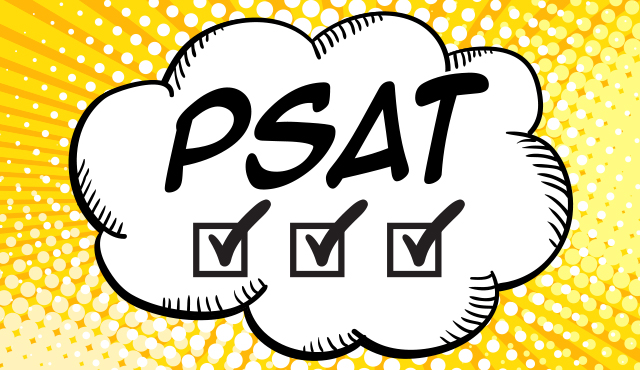
Once upon a time, the standardized test known as the PSAT was viewed as a mini-SAT. And it was, literally, a “mini” version of the exam—a full hour shorter than the SAT. That’s no longer the case.
Taking The PSAT Today
When folks talk about the PSAT, they typically mean the test students take during junior year. Its full name is the PSAT/NMSQT, which stands for Preliminary SAT/National Merit Scholarship Qualifying Test. Here’s a quick breakdown of the three PSAT varieties:
Should You Take the PSAT?
Preparing for the psat.
- PSAT

Explore Colleges For You
Connect with our featured colleges to find schools that both match your interests and are looking for students like you.

Career Quiz
Take our short quiz to learn which is the right career for you.

Get Started on Athletic Scholarships & Recruiting!
Join athletes who were discovered, recruited & often received scholarships after connecting with NCSA's 42,000 strong network of coaches.

Best 389 Colleges
165,000 students rate everything from their professors to their campus social scene.
SAT Prep Courses
1400+ course, act prep courses, free sat practice test & events, 1-800-2review, free digital sat prep try our self-paced plus program - for free, get a 14 day trial.

Free MCAT Practice Test
I already know my score.

MCAT Self-Paced 14-Day Free Trial

Enrollment Advisor
1-800-2REVIEW (800-273-8439) ext. 1
1-877-LEARN-30
Mon-Fri 9AM-10PM ET
Sat-Sun 9AM-8PM ET
Student Support
1-800-2REVIEW (800-273-8439) ext. 2
Mon-Fri 9AM-9PM ET
Sat-Sun 8:30AM-5PM ET
Partnerships
- Teach or Tutor for Us
College Readiness
International
Advertising
Affiliate/Other
- Enrollment Terms & Conditions
- Accessibility
- Cigna Medical Transparency in Coverage
Register Book
Local Offices: Mon-Fri 9AM-6PM
- SAT Subject Tests
Academic Subjects
- Social Studies
Find the Right College
- College Rankings
- College Advice
- Applying to College
- Financial Aid
School & District Partnerships
- Professional Development
- Advice Articles
- Private Tutoring
- Mobile Apps
- International Offices
- Work for Us
- Affiliate Program
- Partner with Us
- Advertise with Us
- International Partnerships
- Our Guarantees
- Accessibility – Canada
Privacy Policy | CA Privacy Notice | Do Not Sell or Share My Personal Information | Your Opt-Out Rights | Terms of Use | Site Map
©2024 TPR Education IP Holdings, LLC. All Rights Reserved. The Princeton Review is not affiliated with Princeton University
TPR Education, LLC (doing business as “The Princeton Review”) is controlled by Primavera Holdings Limited, a firm owned by Chinese nationals with a principal place of business in Hong Kong, China.
What are your chances of acceptance?
Calculate for all schools, your chance of acceptance.
Your chancing factors
Extracurriculars.
What is a Good PSAT Score in 2024? (Freshmen, Sophomores, Juniors)

Is your SAT score enough to get you into your dream school?
Our free chancing engine takes into consideration your SAT score, in addition to other profile factors, such as GPA and extracurriculars. Create a free account to discover your chances at hundreds of different schools.
What’s Covered:
Why is the psat important, how is the psat scored.
- What is a Good Score?
Many students are anxious to predict their performance on high-stakes standardized tests, like the SAT. The PSAT, which is similar in both format and content, can often project how strong a student’s SAT scores will be. In fact, its name used to stand for the Pre-SAT, though in recent years, it has simply become the PSAT.
In this post, we’ll discuss PSAT scores and what qualifies as a high score for students in 9th, 10th, and 11th grade. We’ll also go into which PSAT options exist for freshmen, sophomores, and juniors, along with how your scores might stack up compared to national averages. Keep reading to learn what constitutes a good score on the PSAT.
There are two main reasons why high schoolers take the PSAT. First, it introduces students to standardized testing. Students who take the PSAT gain additional exposure to the content and test-taking strategies of both the PSAT and the SAT.
Taking the PSAT can also set you up to qualify for National Merit Scholarships. The top 1% of 11th-grade test takers qualify for National Merit semifinalist status, and can then go on to compete for scholarships of $2,500. Taking the PSAT as a 9th or 10th grader offers essential preparation if you want your 11th-grade scores to stand out.
What is the National Merit Scholarship?
This highly prestigious national honor—the National Merit Scholarship—has been annually awarded since the 1950s, and recognizes the nation’s most distinguished academic performers. All 11th graders who take the PSAT/NMSQT are eligible for National Merit Scholarships.
Of the top 50,000 performers, 34,000 become Commended Scholars, while the remaining 16,000 are distinguished as National Merit Semifinalists. If semifinalists would like to advance in the process, they submit additional essays, endorsements, and academic performance metrics to be considered for the honor. 15,000 of those students progress to the Finalist round, and 7,250 ultimately receive the distinction of National Merit Scholar. National Merit Scholars receive a $2,500 scholarship to spend on tuition at an accredited college or university.
Additionally, some corporate sponsors award Special Scholarships to certain members of this pool of 50,000 students based on their own scholarship criteria. All of these distinctions—Commended Student, National Merit Semifinalist, National Merit Finalist, Special Scholar, and National Merit Scholar—are remarkable distinctions. Recipients who can cite one or more of these distinctions on their resume tend to be very competitive in the college admissions process.
Which PSAT Should You Take, Based on Your Grade
It’s common for people to use the word PSAT interchangeably with the Preliminary SAT/National Merit Scholarship Qualifying Test (PSAT/NMSQT) that is commonly taken in the fall of a student’s junior year. However, the current PSAT is a collection of three tests that account for the level of knowledge a typical student will have acquired through their coursework. Those three tests are the PSAT 8/9, the PSAT 10, and the aforementioned PSAT/NMSQT.
PSAT 8/9: The PSAT 8/9 is offered to 8th and 9th graders, giving them an opportunity early in their academic careers to prepare for the standardized tests they’ll encounter in the future. There is no fixed date for the PSAT 8/9, as the test is available to take from the fall through the spring. The PSAT 8/9 tests three core areas of knowledge (Reading, Writing and Language, and Math), is twenty minutes shorter than the PSAT/NMSQT (2 hours and 25 minutes), and is scored on a scale of 240-1440.
PSAT 10: The PSAT 10 shares its format with the PSAT/NMSQT—both tests are 2 hours and 45 minutes long and contain the same number of questions (47 for Reading, 44 for Writing and Language, and 48 for Math), and is scored on an identical 320-1520 point scale. The primary difference between the PSAT 10 and the PSAT/NMSQT is that the subject matter tested is adapted for 10th graders and your PSAT 10 score will not qualify you for a National Merit Scholarship. The PSAT 10 is administered to students in the spring of their sophomore year.
PSAT/NMSQT: With the exception of more-advanced subject matter and the chance to qualify for a National Merit Scholarship, the PSAT/NMSQT and PSAT 10 are nearly identical—sharing the same duration, format, and scoring. When compared to the SAT, the PSAT/NMSQT is just 15 questions shorter (with 5 fewer questions in Reading and 10 fewer in Math), 15 minutes shorter than the essay-less SAT, and is scored on a 320-1520 point scale. The other primary difference between the PSAT 10 and the PSAT/NMSQT is not directly used in college admissions. However, an outstanding performance that earns consideration for a National Merit Scholarship will pique the interest of many schools.
Because of its comparatively less-challenging content, the PSAT 8/9 is scored on a slightly different scoring scale than the PSAT 10, PSAT/NMSQT, and SAT—the PSAT 8/9 is scored on a 240-1440 scale. To calculate a test taker’s PSAT 8/9 score, the College Board (the group that administers the test) takes section scores between 6 and 36 and scales them into a 120 and 720 scale—providing one score for Math and the other for Reading as well as Writing and Language (called the Evidence-Based Reading and Writing score). The scaled scores are then added together to tally a composite score between 240 and 1440.
The scoring scales on the PSAT and PSAT 10 are the same, and they are similar to the SAT in format, but different in scale. Students receive section scores of 8–38 in Mathematics, Reading, and Writing & Language. The raw score in Mathematics is scaled to a 160-760 point scale. The average of a student’s Reading and Writing & Language scores is also scaled to a score in the same range of 160–760. Those scaled scores are added together to calculate a composite score, anywhere from 320-1520.
To determine National Merit eligibility, a selection committee looks at students’ three section scores on the 8–38 scale. They double each section’s raw score and add them together for a new number, called the Selection Index. The Selection Index ranges from 48-228.
What Is a Good Score for a Freshman on the PSAT 8/9?
Because of the difference in scoring between the PSAT 8/9 and the PSAT 10 and PSAT/NMSQT, it’s difficult to see how you stack up to other freshmen who took the test by simply comparing composite scores. The best way to see where you are in your PSAT preparation compared to the competition is to look at what percentile your score puts you in.
| 1440 | 99+ |
| 1320 | 99 |
| 1200 | 97 |
| 1100 | 90 |
| 1000 | 76 |
| 900 | 55 |
| 800 | 31 |
| 700 | 11 |
| 600 | 1 |
| 500 | 1- |
Source: PSAT 8/9 Nationally Representative and User Percentiles
Although the PSAT 8/9 can be predictive of success on future standardized tests, it’s important for students to realize that this is just a consequence-free first step in preparing for future tests with higher stakes. More than a score, students should take away a firsthand experience with such a long test that requires intense focus. The PSAT 8/9 is also an excellent place to uncover areas of weakness where scoring gains can be made on future exams.
What is a Good Score for a 10th Grader on the PSAT 10, or an 11th grader on PSAT?
The College Board has set college readiness benchmarks for each grade. If, as a 10th grader, you score at or above a 430 in the Evidence-Based Reading and Writing section of the PSAT 10 and at or above a 480 in Math, you are on track to be college-ready by the time you graduate from high school. For 11th graders, the benchmarks are 460 for Evidence-Based Reading and Writing, and 510 for Math.
Another useful way of comparing PSAT scores is by looking at them in terms of percentiles. Percentile ranks tell a student the percent of other test takers who scored at or below a certain result. For example, a student who achieves a score in the 70th percentile scored as high as, or higher than, 70% of test takers.
The College Board provides these percentiles for 10th graders taking the PSAT and PSAT 10—the percentiles are the same for both the PSAT 10 and the PSAT/NMSQT.
| 1520 | 99+ |
| 1400 | 99 |
| 1300 | 97 |
| 1200 | 92 |
| 1100 | 82 |
| 1000 | 65 |
| 900 | 46 |
| 800 | 24 |
| 700 | 5 |
| 600 | 1- |
Source: PSAT Score Information
Looking at these numbers in context, you can consider your PSAT or PSAT 10 score decent if you land in the 50th percentile, meaning you scored as good as, or better than, half of the students who took the test. This correlates with a composite score of about 920. A good score places you around the 75th percentile, which is a composite score around 1050. An excellent score will place you in the 90th percentile, which equates with a composite score of around 1170.
If you want to see whether your PSAT score is on track to make you eligible for National Merit awards, check your Selection Index. Students who surpass the Selection Index cutoff score for their state become eligible for National Merit recognition. Here are the Selection Index Cutoff Scores by state for the past year:
| Alabama | 212 |
| Alaska | 212 |
| Arizona | 217 |
| Arkansas | 212 |
| California | 221 |
| Colorado | 217 |
| Connecticut | 221 |
| Delaware | 220 |
| DC | 223 |
| Florida | 216 |
| Georgia | 219 |
| Hawaii | 217 |
| Idaho | 214 |
| Illinois | 219 |
| Indiana | 216 |
| Iowa | 213 |
| Kansas | 215 |
| Kentucky | 214 |
| Louisiana | 214 |
| Maine | 214 |
| Maryland | 222 |
| Massachusetts | 222 |
| Michigan | 217 |
| Minnesota | 218 |
| Mississippi | 211 |
| Missouri | 215 |
| Montana | 210 |
| Nebraska | 213 |
| Nevada | 214 |
| New Hampshire | 215 |
| New Jersey | 223 |
| New Mexico | 211 |
| New York | 220 |
| North Carolina | 218 |
| North Dakota | 209 |
| Ohio | 216 |
| Oklahoma | 211 |
| Oregon | 217 |
| Pennsylvania | 219 |
| Rhode Island | 216 |
| South Carolina | 213 |
| South Dakota | 211 |
| Tennessee | 216 |
| Texas | 220 |
| Utah | 212 |
| Vermont | 213 |
| Virginia | 221 |
| Washington | 220 |
| West Virginia | 209 |
| Wisconsin | 214 |
| Wyoming | 209 |
How Do PSAT/NMSQT, PSAT 10, and PSAT 8/9 Scores Correlate with Future SAT Scores?
There is no direct relationship between PSAT scores and SAT scores. Many students who do well on the PSAT go on to achieve strong SAT scores, but this is not always the case. On the other hand, many students who don’t achieve a high score on the PSAT are able to improve significantly before taking the SAT.
The bottom line is that scores from the PSAT/NMSQT and the PSAT 10 should be used as data points to inform future studying. Use the tips below to inform your SAT prep as you move on from the PSAT.
What is the Best Way To Prepare for the PSAT/NMSQT?
Do well in school. At the end of the day, the PSAT assesses your proficiency in mathematics, critical reading, and writing—three skills that are central to any high school curriculum. Therefore, the best way for you to prepare for the PSAT—or the SAT for that matter—is to take your high school coursework seriously.
Take the PSAT 8/9. The PSAT 8/9 provides students with an excellent opportunity to familiarize themselves with the rigors of future standardized tests—which in itself is great practice for the PSAT 10 and PSAT/NMSQT. It also provides insight into areas that need improvement, showing students where to focus when preparing for future exams.
Take the PSAT 10 and PSAT/NMSQT practice tests. If you are currently a 10th grader and haven’t yet taken the PSAT 10, we recommend taking the exam to familiarize yourself with the format and content of the PSAT. Next year’s PSAT/NMSQT will be more difficult than the PSAT 10 that you might take this year, but the two are similar and have nearly identical formatting.
The score report you’ll receive from official PSAT sittings is extensive. They include subscores for each section that highlight areas of success and those for improvement. You can even use the “Your Scores: Next Steps” section to identify the specific skills that you need to work on.
If you’ve already taken the PSAT 8/9 and PSAT 10, you should familiarize yourself with the PSAT/NMSQT. The College Board has free practice tests and review questions that you can do at home.
Begin your SAT preparation early. If you want to hit two birds with one stone, consider signing up for SAT prep in the summer before your Junior year. If you have already completed your SAT prep by the time the PSAT is administered, then you are much more likely to score within the range for National Merit consideration. Plus, you will already have taken the SAT, giving you lots of time to focus on other aspects of your college application.
The PSAT is only one small part of your overall college application, so don’t feel as though you have to dedicate hours each week to improving your score. Rather, use your PSAT 10 scores to see if you are on track. Ask yourself:
- Based on the college readiness benchmarks, am I on track to be prepared for college when it starts?
- Does my Selection Index suggest that I may be considered for National Merit Scholarships?
- Is there one subject or question type for which I could use additional preparation?
Use your PSAT 8/9 and PSAT 10 to gauge what preparation you can do now to set yourself up for success in the months ahead. If you’d like more information on how to do well on the PSAT, check out the College Board’s free practice tests as well as our PSAT Info and Tips .
How Does Your PSAT Score Impact Your College Chances?
While your PSAT score will not have the same weight as your SAT or ACT score in the college admissions process, your score can still impact your chances. A high enough score can earn you the title of Commended Student, Semifinalist, Finalist, or Scholar—all of these titles are prestigious achievements that you can add to your Honors section in the Common App.
Plus, taking the PSAT is an excellent way to prepare for the SAT and earn a score that will make you stand out. If you’re curious about whether you’re on track to an SAT score that will be competitive at your top choice schools, check out CollegeVine’s free chancing engine , which provides you with personalized chances of acceptance at each of your schools based on your grades, extracurriculars, course rigor, and yes, SAT scores. This tool allows you to see just how much of a boost a high score could give you.
Related CollegeVine Blog Posts

- Search All Scholarships
- Exclusive Scholarships
- Easy Scholarships to Apply For
- No Essay Scholarships
- Scholarships for HS Juniors
- Scholarships for HS Seniors
- Scholarships for College Students
- Scholarships for Grad Students
- Scholarships for Women
- Scholarships for Black Students
- Scholarships
- Student Loans
- College Admissions
- Financial Aid
- Scholarship Winners
- Scholarship Providers
Student-centric advice and objective recommendations
Higher education has never been more confusing or expensive. Our goal is to help you navigate the very big decisions related to higher ed with objective information and expert advice. Each piece of content on the site is original, based on extensive research, and reviewed by multiple editors, including a subject matter expert. This ensures that all of our content is up-to-date, useful, accurate, and thorough.
Our reviews and recommendations are based on extensive research, testing, and feedback. We may receive commission from links on our website, but that doesn’t affect our editors’ opinions. Our marketing partners don’t review, approve or endorse our editorial content. It’s accurate to the best of our knowledge when posted. You can find a complete list of our partners here .
What Is the PSAT?

Sawyer Hiton is a former scholarship and financial aid writer with Scholarships360. Previously, Sawyer worked with the nonprofit College Possible, supporting high school juniors in beginning their college plans and applications. Sawyer graduated from Kenyon College with a degree in Philosophy.
Learn about our editorial policies

Maria Geiger is Director of Content at Scholarships360. She is a former online educational technology instructor and adjunct writing instructor. In addition to education reform, Maria’s interests include viewpoint diversity, blended/flipped learning, digital communication, and integrating media/web tools into the curriculum to better facilitate student engagement. Maria earned both a B.A. and an M.A. in English Literature from Monmouth University, an M. Ed. in Education from Monmouth University, and a Virtual Online Teaching Certificate (VOLT) from the University of Pennsylvania.

PSAT stands for “Preliminary Scholastic Aptitude Test.” The PSAT is a test most sophomores and some juniors take to prepare for the SAT , a larger college readiness exam. But it can be more than just practice. If you do well on the PSAT you become eligible to earn scholarships. Doing well on the PSAT can also strengthen your college applications.
A little more about the PSAT
You can only take the PSAT once a year. Many high schools require their sophomores to take the test. For juniors, it is optional, but if you do well on the test this year you could qualify to receive a National Merit Scholarship . If you’re good at standardized tests, or just want some more SAT practice, it’s a great idea to take the PSAT your junior year .
Structure of the PSAT
The PSAT is 2 hours and 15 minutes long, and consists of a reading and writing section, as well as a math section. It recently switched to a digital format along with the SAT . Below is a breakdown of all the PSAT sections.
Reading and writing
The reading section of the PSAT tests your ability to read a passage, glean relevant information, and answer questions regarding evidence, words in context, and general analysis. Even if reading isn’t your best subject, you can still find a home in PSAT reading. The section is composed of literature, history, social science, and science passages, so you’re likely to resonate with at least one of the topics!
The writing section tests your ability to locate and correct grammatical errors. You’ll also be asked to revise words and phrases to better the text. Much of what shows up here you’ll have learned in English classes, or just through your daily conversations.
PSAT math is broken down into two sections, both involve multiple choice answers as well as write-in answers. Some questions are made up of two answers, where the first is used to discover the second.
How is the PSAT scored?
Each correct answer you get on the PSAT counts as one point towards your raw score. Points aren’t deducted if you get questions wrong, so use the process of elimination and guess away! Your raw score is converted to your scaled score and your composite score is the combination of each section’s scaled score. Composite scores range from 320-1520. On top of receiving your PSAT composite score, you’ll also receive:
- How you did in each section, as well as categories within those sections
- Your percentile ranks, which show how you did compared to other test takers
- College readiness benchmarks, which show you if you are or are not on track for college
Learn what you need to work on for your SAT
Perhaps more importantly than college readiness, your PSAT score report will reveal to you what you need to work on for your SAT. You’ll be able to access an online PSAT report in which you can see how you did on each question. This can be an incredibly helpful guide as you set forth to prepare for the SAT (or ACT) !
Read more: PSAT to SAT score conversion
What score do you need to qualify for the National Merit Scholarship?
The short answer is, a high one. PSAT scores are automatically sent to the National Merit Scholarship , where a select number of testers from each state are “semifinalists”. These end up being less than 1% of high school students, or in other words, the 99th percentile. Semifinalists then need to go through certain steps to apply for the actual scholarship. These include writing an essay, submitting an excellent transcript, and taking the SAT or ACT and receiving equally high scores. It isn’t easy to become a National Merit Scholar, but this scholarship is special because it’s one of the few you automatically qualify for!
Related: What is a high SAT Score?
What’s next in your PSAT journey?
Most high schools offer the PSAT in October . Talk to your counselor to learn the specific dates of your school. Sophomores are automatically signed up. If you want to take the test as a junior, you’ll have to sign yourself up. Your counselor will support you in doing this.
The PSAT can be a great opportunity to practice your standardized testing and receive detailed feedback. You might just qualify for a bundle of scholarship money in the process. Either way, it is nothing to fear, and everything to be eager for during this next phase of your college preparation!
Preparing for the SAT
Once you’ve taken the PSAT, you’ll have taken a great step towards preparing for the “real thing” – the SAT. You can use your PSAT results to fine-tune your studying and ensure that you are as prepared as possible. Examine the areas that you did well in and the areas where you have room for improvement. This will help you to discover how to improve!
Key Takeaways
- The PSAT is a test that students take to help prepare for the actual SAT
- Taking the PSAT can be a great way to identify what areas you may need to strengthen before taking the actual SAT
- While taking the PSAT and receiving a poor score won’t count against you, receiving a good score may work in your favor and nominate you for a National Merit Scholarship
- Don’t forget that you can prepare for the PSAT in many of the same ways that you prepare for the actual SAT
Start your scholarship search
- Vetted scholarships custom-matched to your profile
- Access exclusive scholarships only available to Scholarships360 members
Frequently asked questions about the PSAT
What does the psat test do, can i take the psat online, do colleges look at the psat, does the psat have an essay, scholarships360 recommended.

10 Tips for Successful College Applications

Coalition vs. Common App: What is the difference?

College Application Deadlines 2023-2024: What You Need to Know
Trending now.

How to Convert Your GPA to a 4.0 Scale

PSAT to SAT Score Conversion: Predict Your Score

What Are Public Ivy League Schools?
3 reasons to join scholarships360.
- Automatic entry to our $10,000 No-Essay Scholarship
- Personalized matching to thousands of vetted scholarships
- Quick apply for scholarships exclusive to our platform
By the way...Scholarships360 is 100% free!
Does the PSAT/NMSQT have an essay?
No, the PSAT/NMSQT does not have an essay.
Also Found On
Does the PSAT Matter? Should You Study For It?
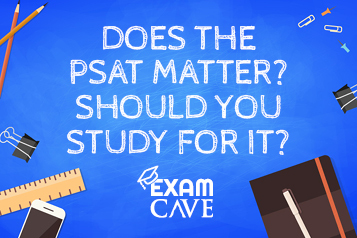
While most high school students know about the SAT, the PSAT is a bit more elusive. Many schools administer the Preliminary SAT to sophomores and juniors early in the school year. Since colleges don’t use the PSAT to determine your admissions decision, most students take it without preparation as a sort of practice SAT. However, this exam holds more significance than you may think.
Table of Contents
Improves Your Standardized Test Performance
Indicates future sat scores, qualifies you for the national merit scholarship, take practice tests, get a tutor, read and write more, review old material, final thoughts.
Standardized tests have a specific format, unlike any other exam. Whether you take the SAT or an AP exam, you will find similarities in the testing process.
These exams have timed sections . Once the time has run out for that portion, you cannot go back and edit your work. To succeed under these conditions, you will need to manage your time wisely and perform well under pressure .
A common strategy is to skip over challenging questions and come back to them later. This technique often works because you do not lose points for not answering problems , ensuring you answer all that you know. However, you may run out of time and be unable to return to the skipped questions.
The PSAT follows a similar format to the SAT in terms of sections, including reading, writing, calculator math, and non-calculator math portions. Each has a time limit. The multiple-choice responses are designed to trick you, so you will have to effectively eliminate the incorrect options.
Many students face testing anxiety, which can negatively impact your score. Taking a similar test, like the PSAT, will expose you to a comparable environment. The PSAT can give you more confidence in your standardized testing abilities, thus improving your SAT score.
Remember that the SAT is longer than the PSAT and has an essay section. Also, scoring well on the PSAT does not mean you do not have to prepare for the SAT at all.
The PSAT is a fantastic way to become familiar with the SAT’s content and format. It can teach you imperative test-taking strategies, such as time management and answer elimination. Taking the PSAT may reduce your test anxiety by giving you a sense of your SAT performance.
Your PSAT score often correlates to the SAT . Areas in which you perform poorly on the PSAT indicate the skills you will need to refine before taking the SAT. Your grades are not the best indicators because they generally do not put you under the same pressure and time constraints, and the content tested on in class may not encompass the standardized information.
The PSAT is scored from 320-1520, while the SAT goes from 400-1600. The SAT math section is more complicated than the PSAT as it includes an additional year of material. Since the SAT takes 15-65 more minutes (depending on the essay), students may feel more fatigued at the end.
An SAT score might be 50-100 points lower than the PSAT if one does not prepare for it . To compensate for this difference, you’ll need to study for the SAT, even if you scored highly on the PSAT.
Sophomores take the PSAT10, and juniors take the PSAT/NMSQT. NMSQT stands for the National Merit Scholarship Qualifying Test. The National Merit Corporation uses PSAT scores to determine if students qualify as a National Merit Semifinalist.
Students who score in a fraction of the top 1% on the PSAT qualify as a semifinalist. About 16,000 students become semifinalists, and from there, 15,000 become finalists. Approximately half of the finalists become National Merit Scholars. National Merit Corporation awards the scholars $2,500.
Becoming a National Merit Finalist opens the door to a world of scholarship opportunities . Many colleges and universities offer partial- to full-tuition to qualifying students . However, the PSAT is not the only determinant of receiving this title.
Once you have gotten your PSAT scores back, you will know if you qualify as a semifinalist. From there, you will need to make your application. You submit your academic record, an essay, and a recommendation letter. Your SAT score affects the decision, and it must be comparable to your PSAT.
While most semifinalists become finalists, any discrepancies in your GPA, SAT, essay capabilities, and personal conduct can eliminate you from this spot.
How to Study For the PSAT
Scoring highly on the PSAT has many benefits, so now you may be wondering how to study for it. Below are several strategies to improve your score.
To acclimate yourself to the time limits and format, you may want to take practice tests . These include similar questions and are available online. To represent the test accurately, ensure you only have a calculator, pencil, paper, and a timer present. Timing yourself will help with time management.
Some online resources include practice questions focused on your weakest areas . These problems will help you improve your skills without over-testing your strong suits. Be sure to check out our recommendations on the best PSAT study prep books on the market.
A PSAT tutor will test you on all the requirements and deliver personalized training to make you a well-rounded test taker. They can teach you strategies compatible with your learning style and offer practice materials that refine your skills. Even the brightest students can benefit from a tutor as they can micro analyze your talents to perfect them.
If you struggle in the reading comprehension and writing sections, reading well-written books can teach you sentence structure, vocabulary, and understanding without additional work. A book that interests you will cause you to naturally find the story’s purpose, the characters’ motives, and various literary techniques.
Well-reviewed, classic novels often have study guides, summary notes, and practice questions online to help you with reading comprehension. However, any book should help with your reading skills.
Many websites offer prompts and contests to practice your writing skills . Reading exposes you to new words and phrases, as well as grammar and organization. Synthesizing this knowledge into a writing prompt will help you improve your essay. Public contests often have people review your writing, and they can provide tips and pointers to hone your techniques.
Remember to save your homework! Redoing old problems, homework, and tests from your math classes can refresh your memory and provide much-needed practice. The main courses tested are Algebra I, Geometry, and Algebra II . If you have not used one of these skills in a while, you may want to review it.
Even students in advanced classes like Calculus may struggle in the math section. While Calculus will often use algebraic techniques, it does not feature much geometry. Furthermore, many courses outside of algebra seldom use particular algebraic skills, so you will want to review your notes.
The PSAT matters. Not only will it prepare you for college admissions tests like the SAT and ACT, but it can also qualify you for tons of scholarships. It provides a marker for future scores, tells you what you need to work on, and acclimates you to the standardized testing environment. Being able to put “National Merit Finalist” on your college resume instantly increases your chances of getting into competitive schools and saves you tons of money on student loans.
Study strategies for the PSAT mirror those of the SAT, so you may as well start early. Maybe the SAT will seem like a breeze if you prepare well enough.
Michelle Tsou
Contributor at ExamCave. Michelle graduated with a BA in English from Portland State University. She hopes to one day run her own test-prep organization.

IMAGES
VIDEO
COMMENTS
PSAT Sections. Just like the SAT, the PSAT includes two sections—Evidence-Based Reading & Writing and Math—comprised of three tests: Reading, Writing & Language, and Math. There is no Essay. Here's what you can expect on each test section.
However, since the PSAT does not include an essay component, there are no specific scoring or tips related to essays. Taking the PSAT/NMSQT. The PSAT/NMSQT is an important exam students typically take in 11th grade, although some schools may offer it to 10th graders. It is administered at schools during October and provides students with ...
Scores range from 320 to 1520 and are on the same score scale as the SAT. This means that a score of 1100 on the PSAT/NMSQT is equivalent to a score of 1100 on the SAT. The only difference is that SAT scores range from 400 to 1600, because the difficulty level of the questions is higher than on the PSAT/NMSQT. Students also receive a PSAT/NMSQT ...
The two tests are extremely similar; the main difference is that the PSAT doesn't have an optional essay section. ... you can think of the Writing section as containing two main types of questions—those that have to do with little picture changes, like grammar and punctuation, and those that ask about big picture changes, ...
No, the PSAT does not have an essay component. It consists only of multiple-choice sections, including Reading, Writing and Language, and Math. Don't worry about preparing for any written essays for the PSAT. Focus your studies on the areas mentioned, practice with sample questions, and make sure you're comfortable with the test format.
The PSAT Math Test: What to Expect. The PSAT Math section includes 44 questions divided between two modules. You have 35 minutes to answer the questions in each module. The PSAT math section tests your ability in four content areas: algebra, advanced math, problem-solving and data analysis, and geometry and trigonometry.
The PSAT 8/9 tests the same skills and knowledge as the PSAT 10 but in a way that's appropriate for eighth and ninth graders. Do students have to write an essay on the PSAT 10? No, the PSAT 10 does not have an essay. Can homeschooled students take the PSAT 10? Yes. Homeschooled students can contact a local school and arrange to take the PSAT 10 ...
As it stands, the PSAT is heavily connected to the SAT. One of the test's primary purposes is to act as a precursor to the SAT—as the name suggests, as an SAT practice test. Thus, the PSAT and SAT heavily mirror each other in regard to content, structure, and even scoring. But the two tests aren't identical.
Hey there! No need to worry about essays when it comes to the PSAT—you're in the clear! The PSAT consists entirely of multiple-choice questions and grid-in answers. There is no essay portion on the PSAT, so you can focus entirely on sharpening your skills in the areas of reading, writing, and math. Good luck with your prep!
Hi there! The PSAT, or Preliminary SAT, is essentially a practice version of the SAT. It's also known as the National Merit Scholarship Qualifying Test (NMSQT) for juniors. While the content and structure are very similar to the SAT, it's a bit shorter and doesn't include an essay section. High school students usually take the PSAT in the fall of their junior year, which is the official year ...
PSAT Writing and Language - An Overview of the PSAT Writing and Language Section. The PSAT Writing section consists of a total of 44 multiple-choice questions to be answered in 35 minutes. The Writing section asks you to read passages, find mistakes and/or weaknesses, and fix them. Below you can find more detailed information about the specific ...
That's right: the PSAT has no essay. The SAT, on the other hand, does. It's optional, so you don't have to take it. But as your colleges might require or recommend it, you should be aware that this is one aspect of the SAT that the PSAT won't prepare you for. As a result, make sure you give the essay some attention before you dive into the SAT.
No. Students do not need to write an essay on the PSAT 10. Help Center: Students; Help Center: Professionals and Educators; Help Center: K-12 Reporting Portal
Does the PSAT Have an Essay? There is no Essay section of the PSAT. The standardized test has 2 main sections, the EBRW section and Math section, and nothing else. In the past, the SAT used to have an optional Essay section but the College Board decided to stop offering it altogether. On the other hand, the PSAT never had an optional Essay ...
The PSAT 10 and the PSAT 8/9 do not qualify students for National Merit-related scholarships. ... although the SAT also contains an essay and the PSAT does not. For many students, the PSAT is ...
Essay: PSAT vs. SAT. One major difference between the PSAT and the SAT is that the SAT offers an optional essay question. The PSAT does not. SAT test-takers who choose to write the essay have 50 minutes to complete it. Students read a provided passage and explain how the author creates an argument to persuade his or her audience. The ...
In a word—yes. Here are four reasons why you should take the PSAT. 1. You may have to. Most high schools require their students to take the PSAT in the fall of junior year (and many pick up the $16 cost), either for their own assessment or for a state requirement. Many schools additionally require the PSAT 8/9 and the PSAT 10.
They do cover the same subjects, but the SAT's material is a bit more advanced, reflecting the expectation that students will have learned more by the time they take the test. 3. Length. The SAT without the essay is 20 minutes longer than the PSAT; with the essay, it's more than an hour longer.
PSAT 10: The PSAT 10 shares its format with the PSAT/NMSQT—both tests are 2 hours and 45 minutes long and contain the same number of questions (47 for Reading, 44 for Writing and Language, and 48 for Math), and is scored on an identical 320-1520 point scale. The primary difference between the PSAT 10 and the PSAT/NMSQT is that the subject ...
PSAT stands for "Preliminary Scholastic Aptitude Test.". The PSAT is a test most sophomores and some juniors take to prepare for the SAT, a larger college readiness exam. But it can be more than just practice. If you do well on the PSAT you become eligible to earn scholarships. Doing well on the PSAT can also strengthen your college ...
You may have heard the term PSAT mentioned during high school, especially during the start of the school year. However, some students may not fully understand the purpose of the PSAT. ... However, it does not have an essay portion. The test is normally given in October and students can sign up through their high school. There is a $12 fee for ...
No, the PSAT/NMSQT does not have an essay. Help Center: Students; Help Center: Professionals and Educators; Help Center: K-12 Reporting Portal
The PSAT is scored from 320-1520, while the SAT goes from 400-1600. The SAT math section is more complicated than the PSAT as it includes an additional year of material. Since the SAT takes 15-65 more minutes (depending on the essay), students may feel more fatigued at the end. An SAT score might be 50-100 points lower than the PSAT if one does ...